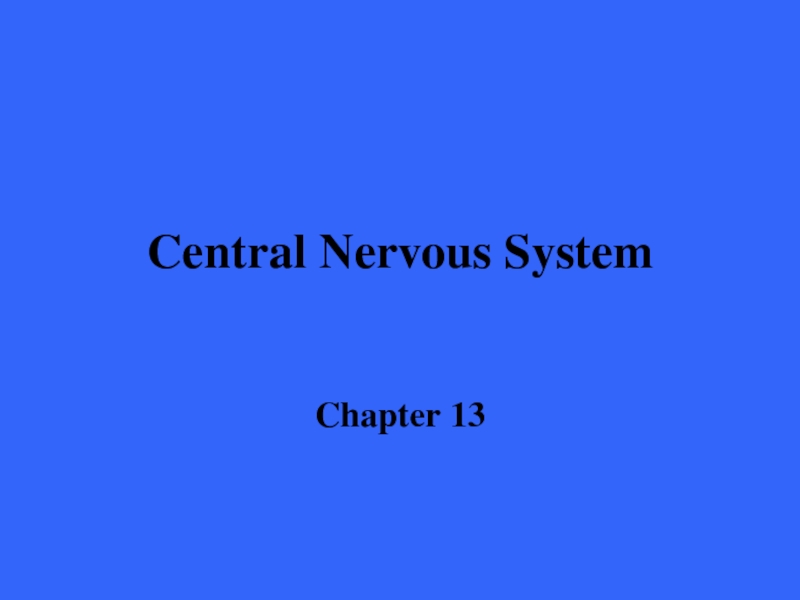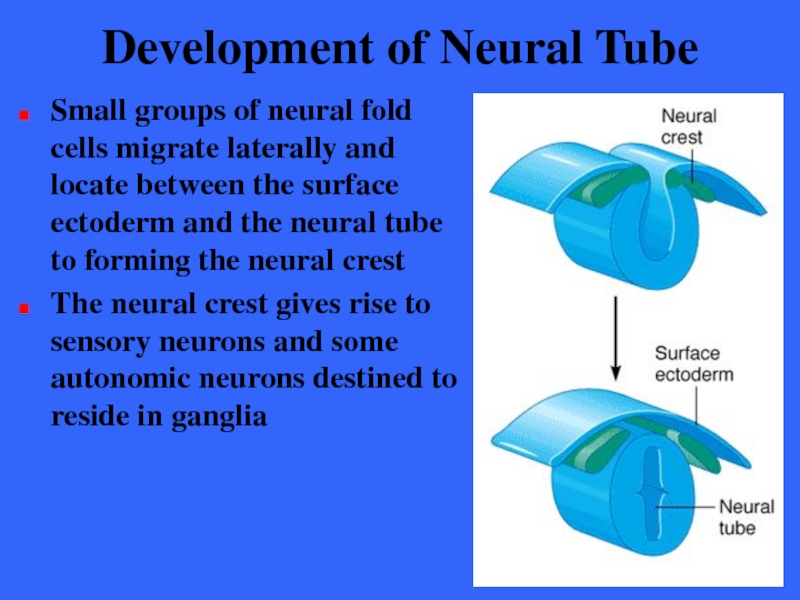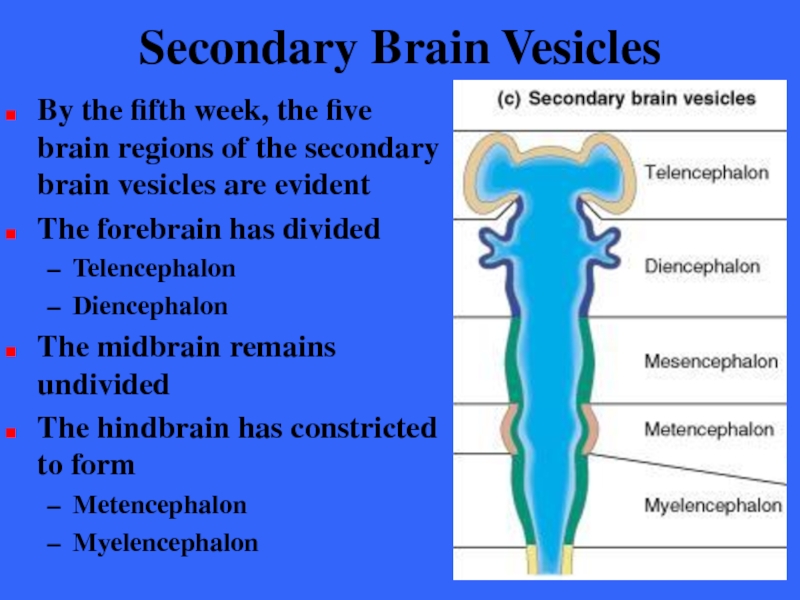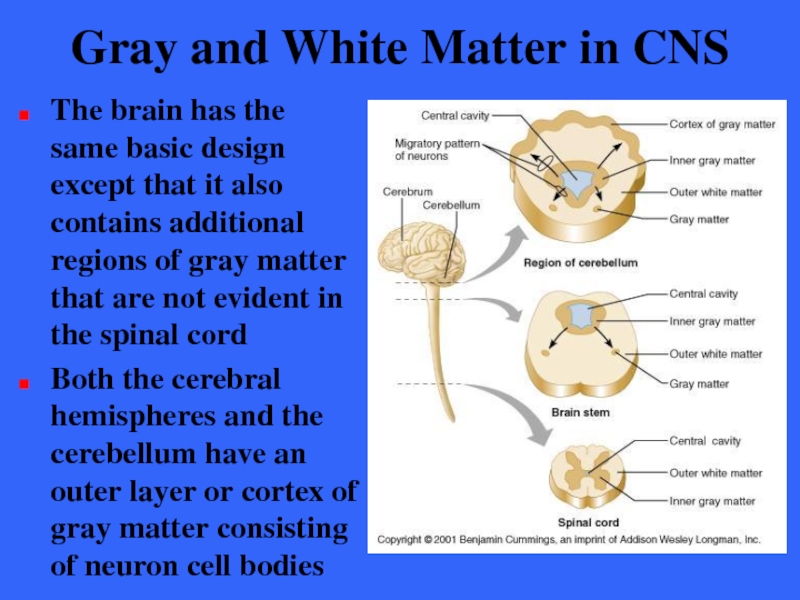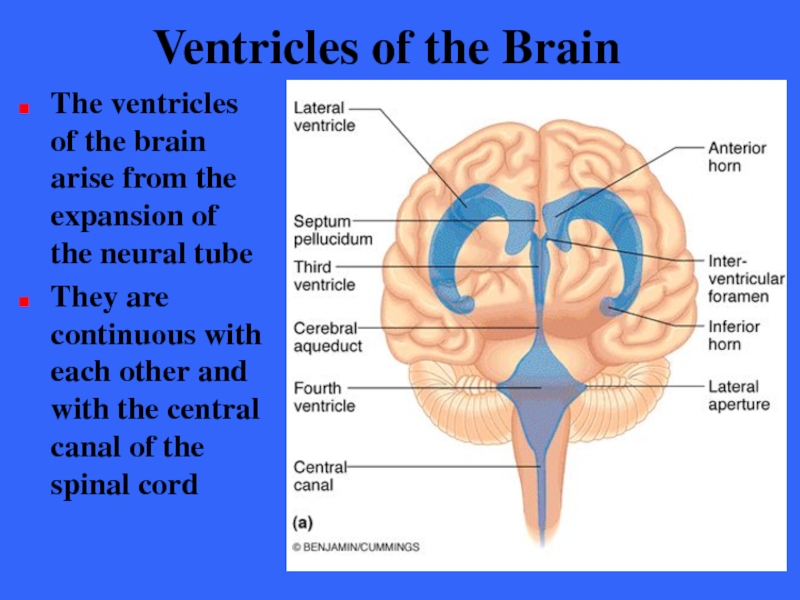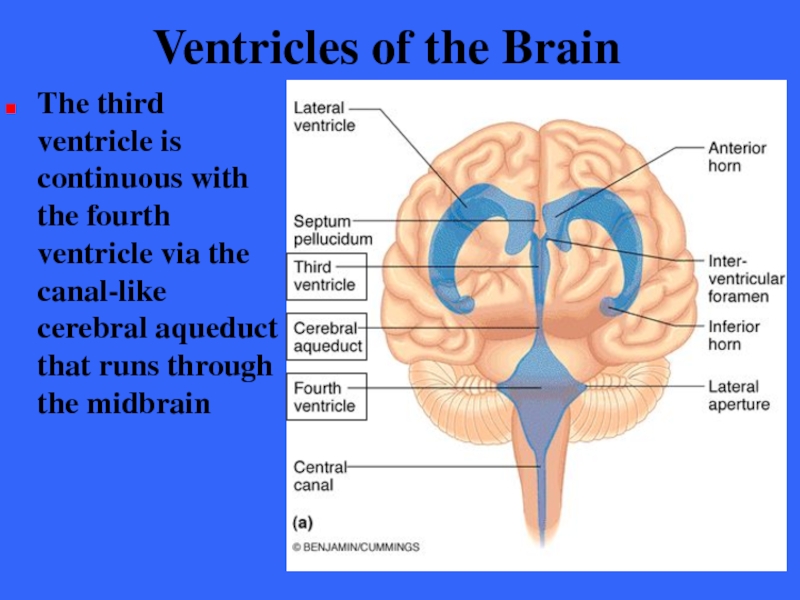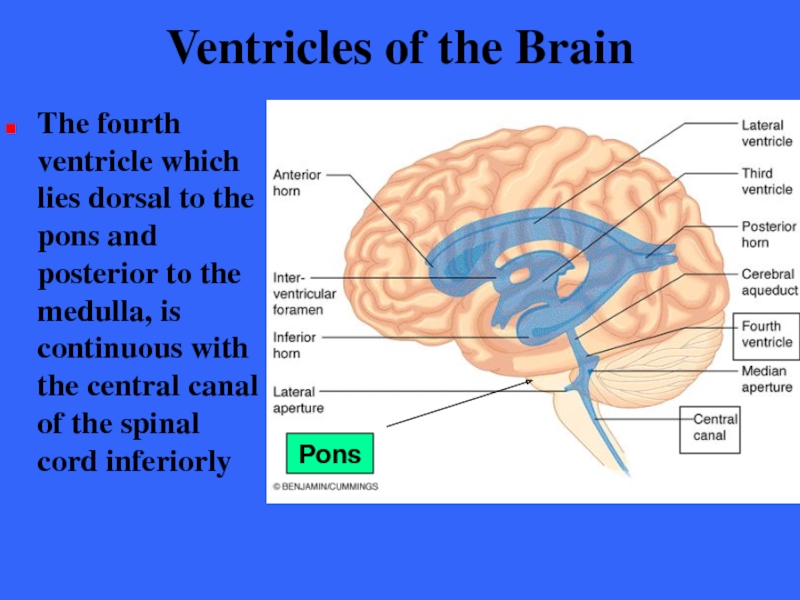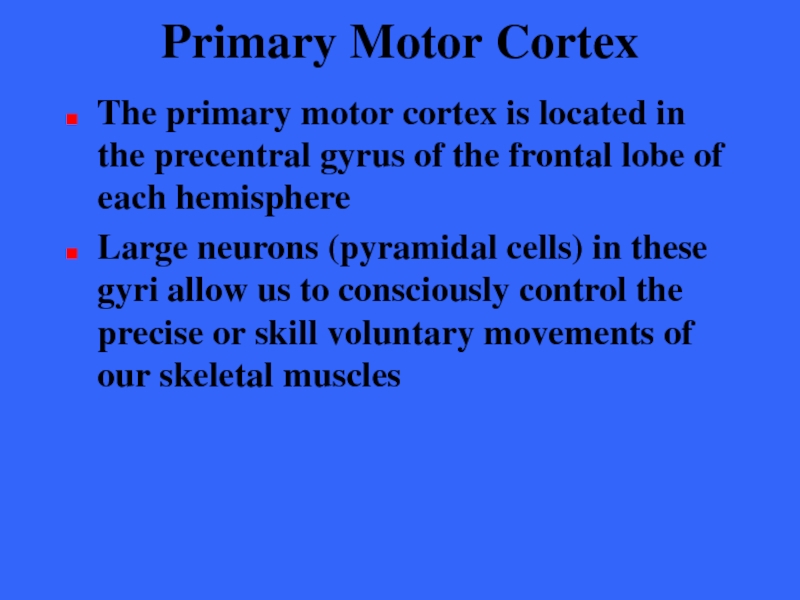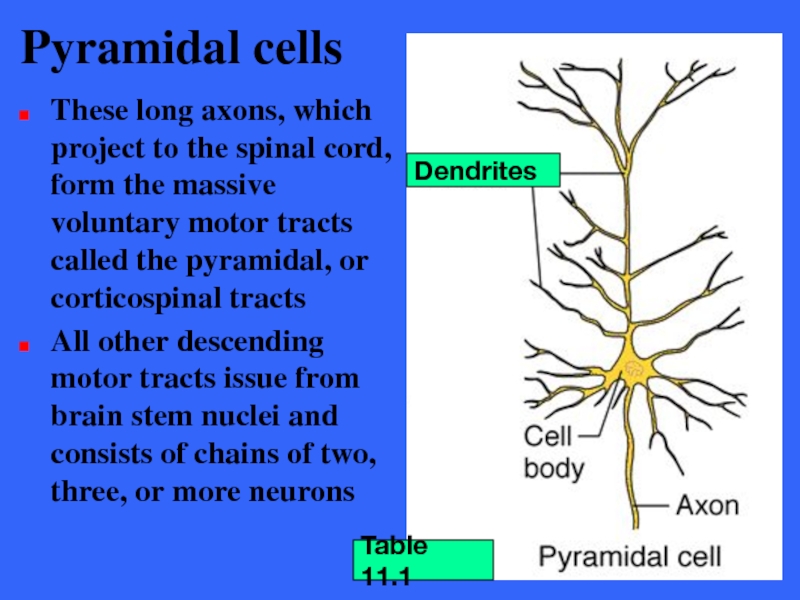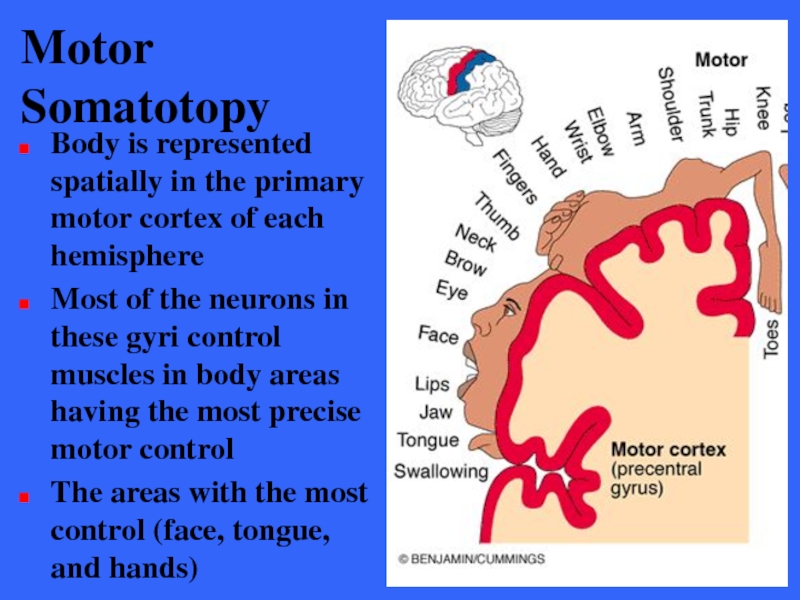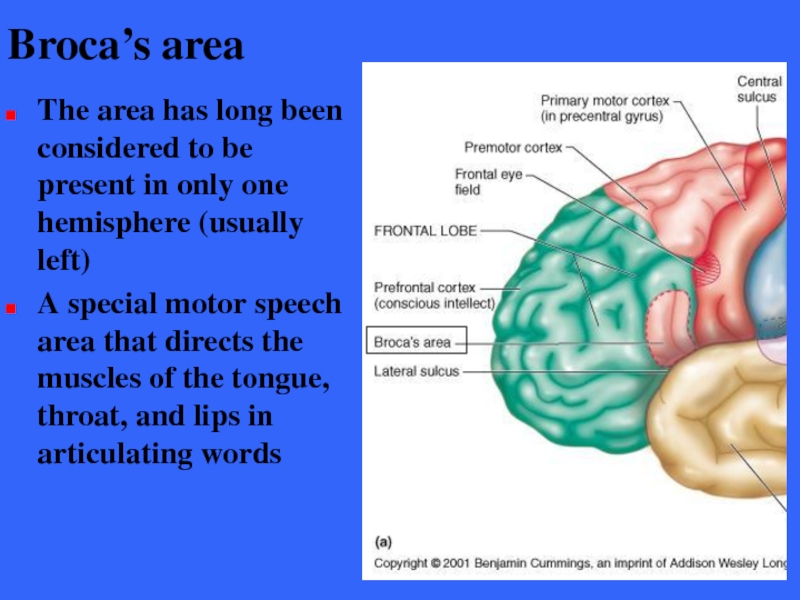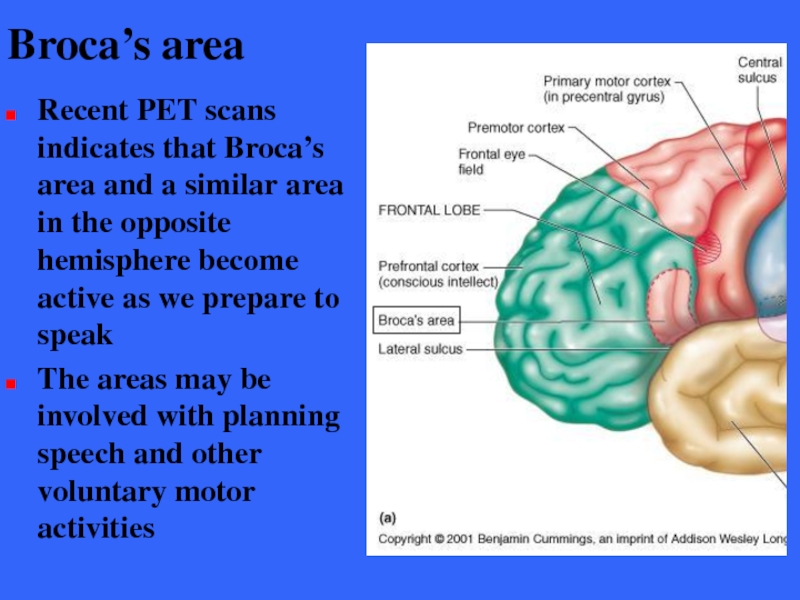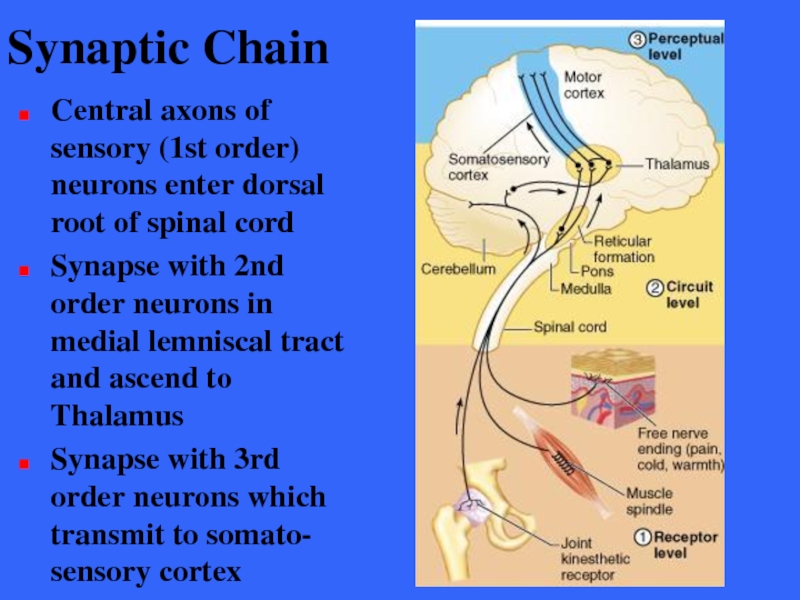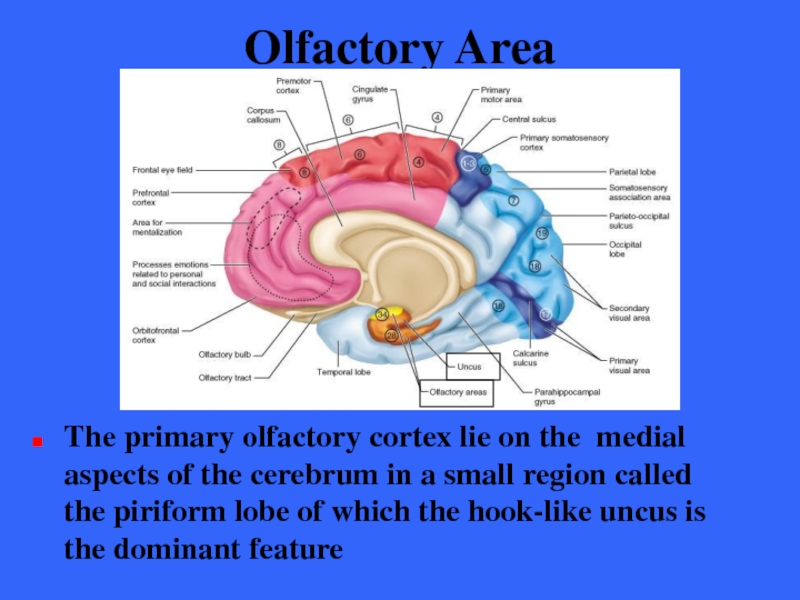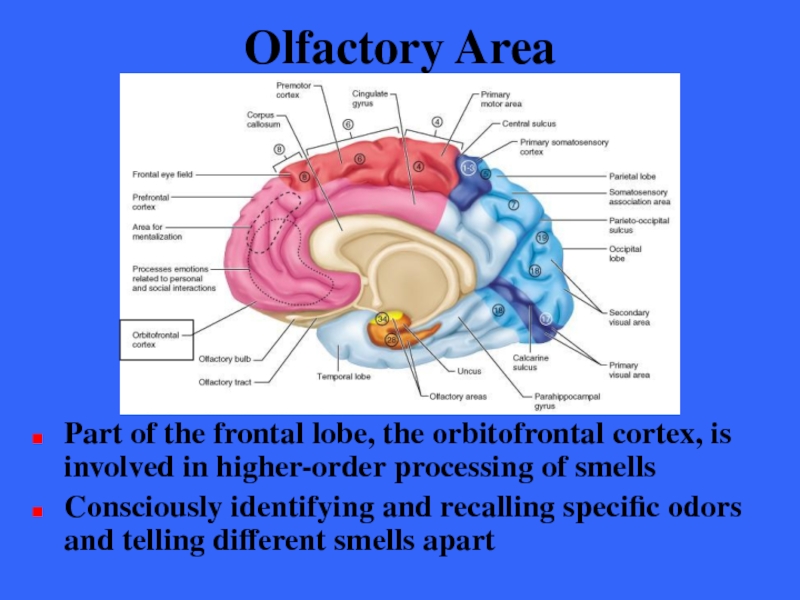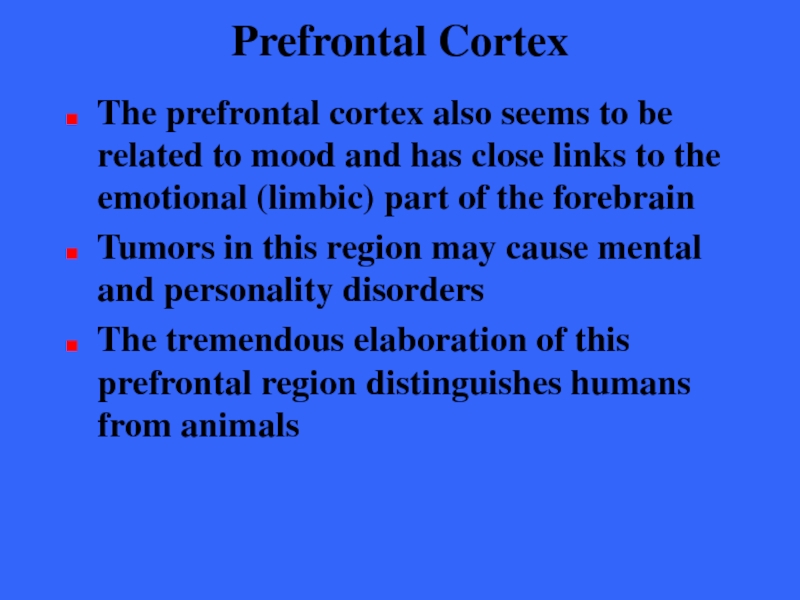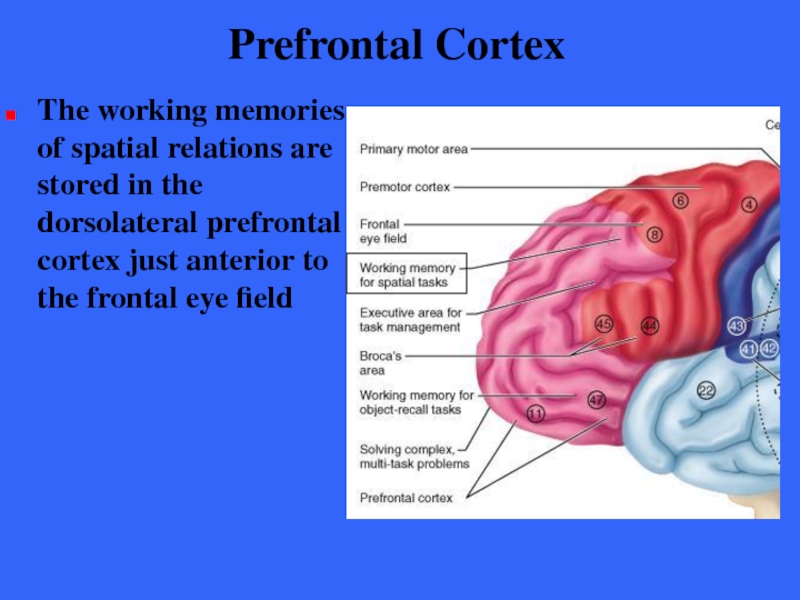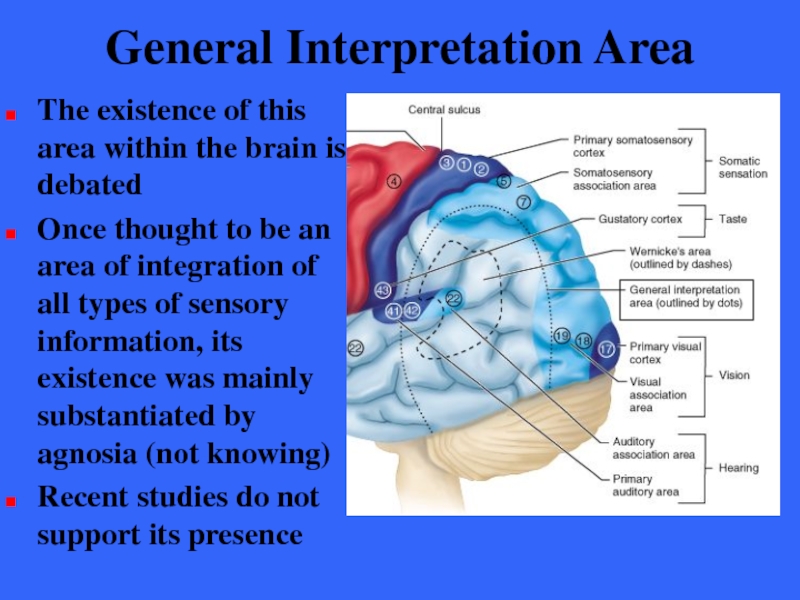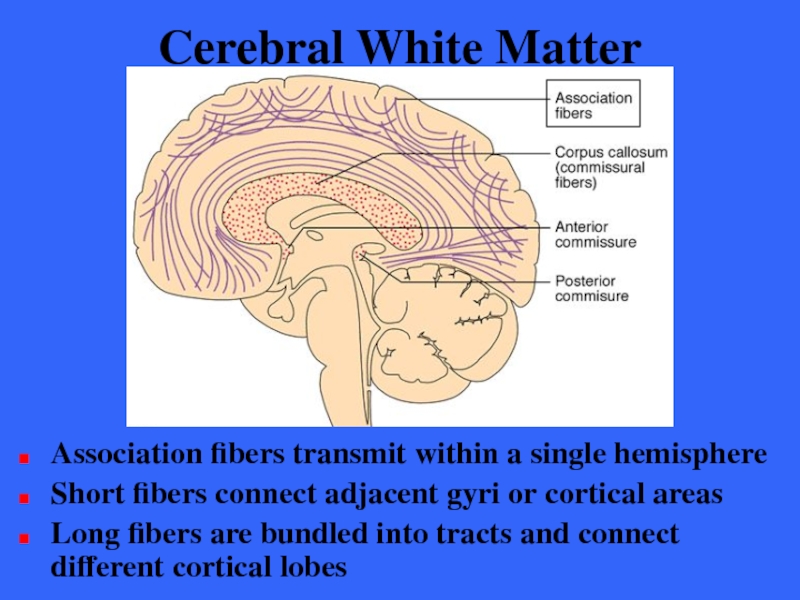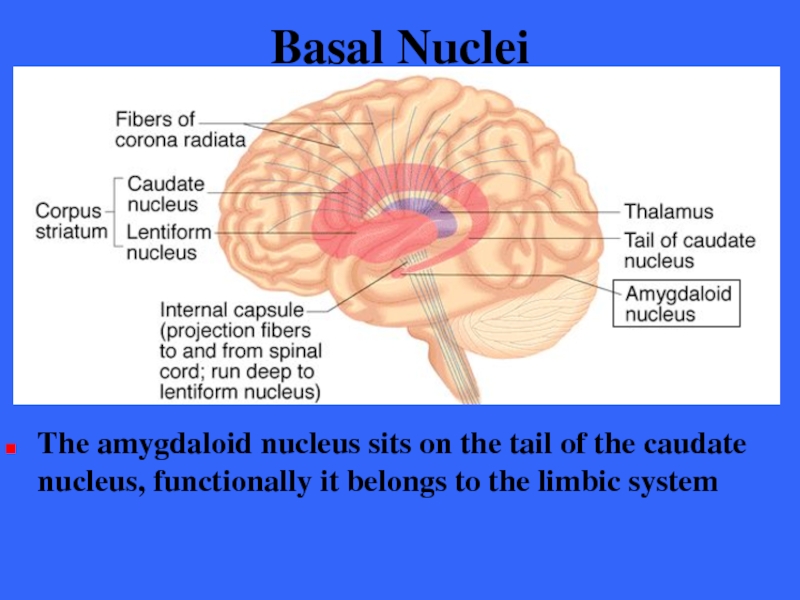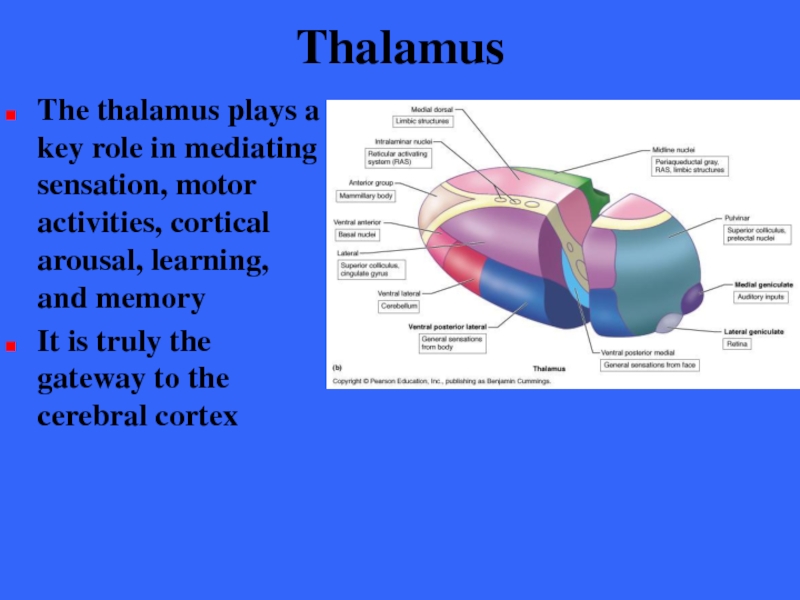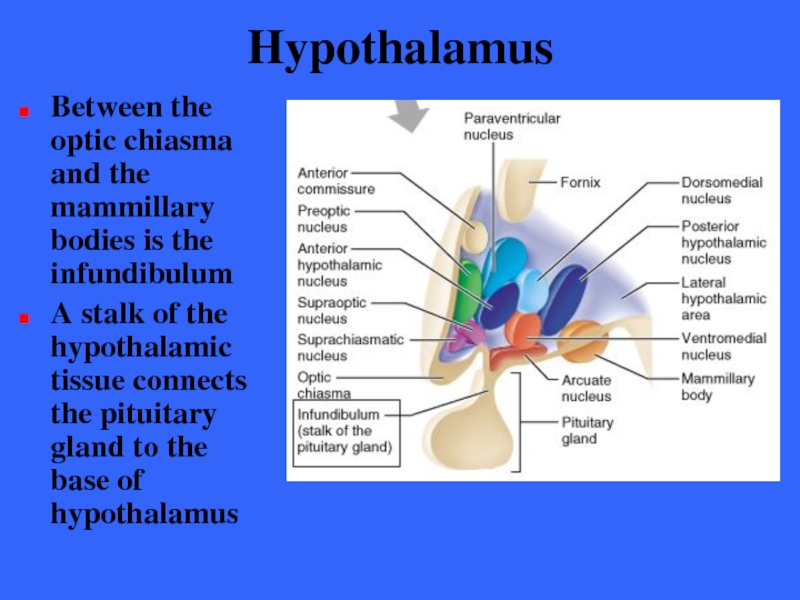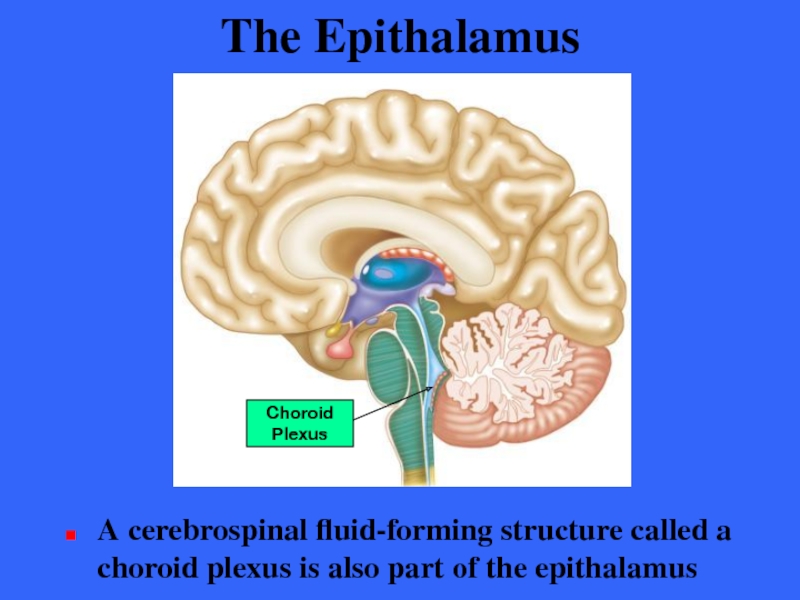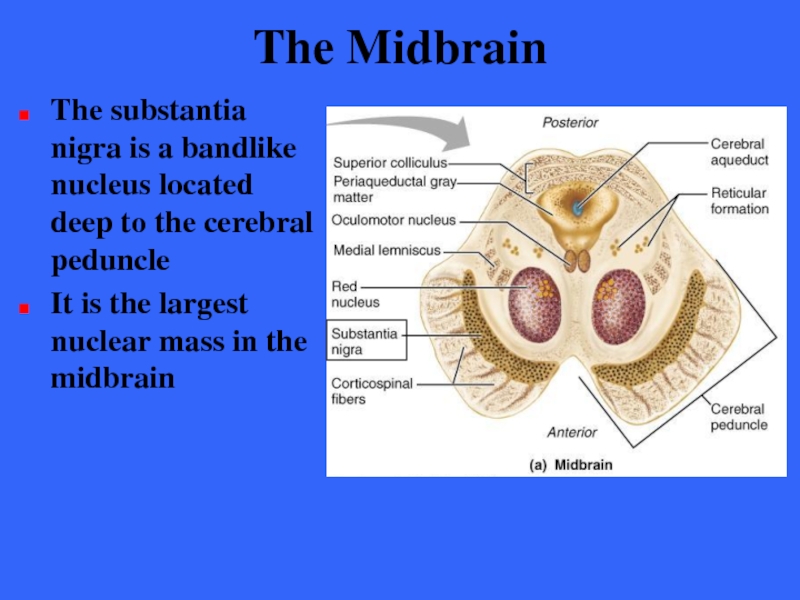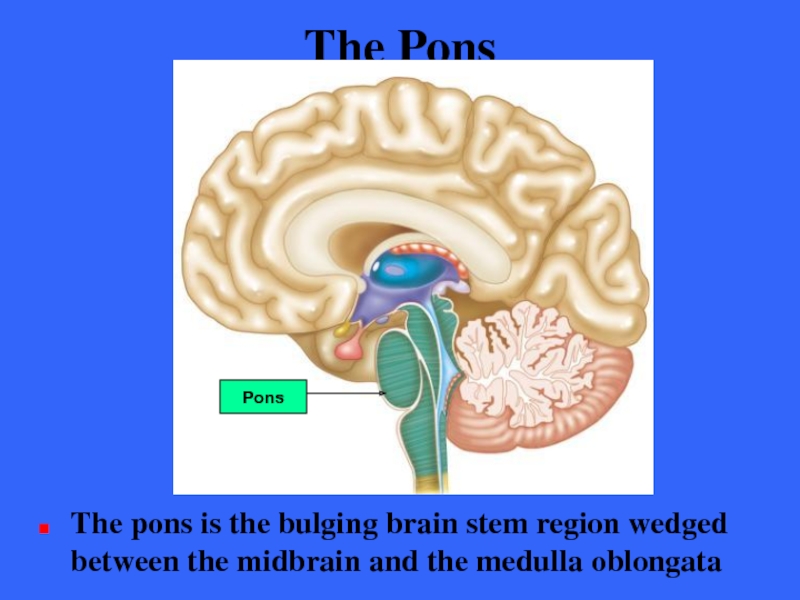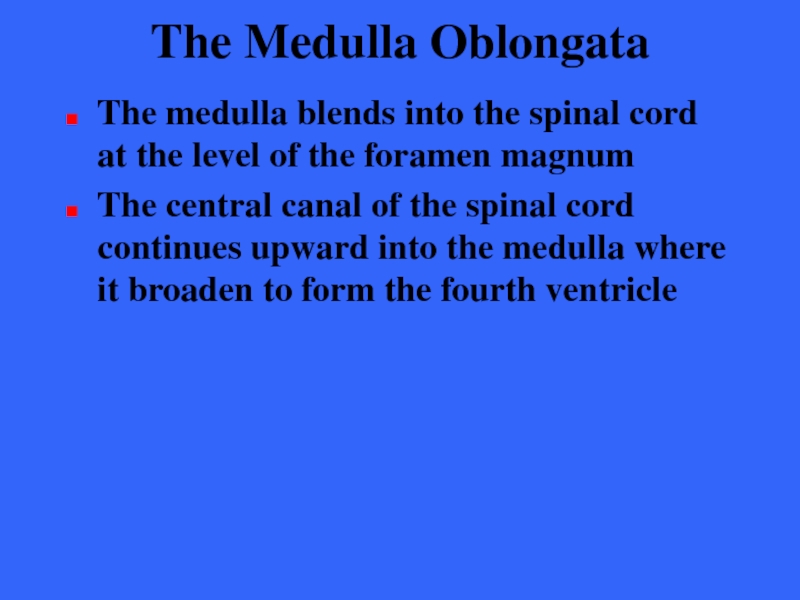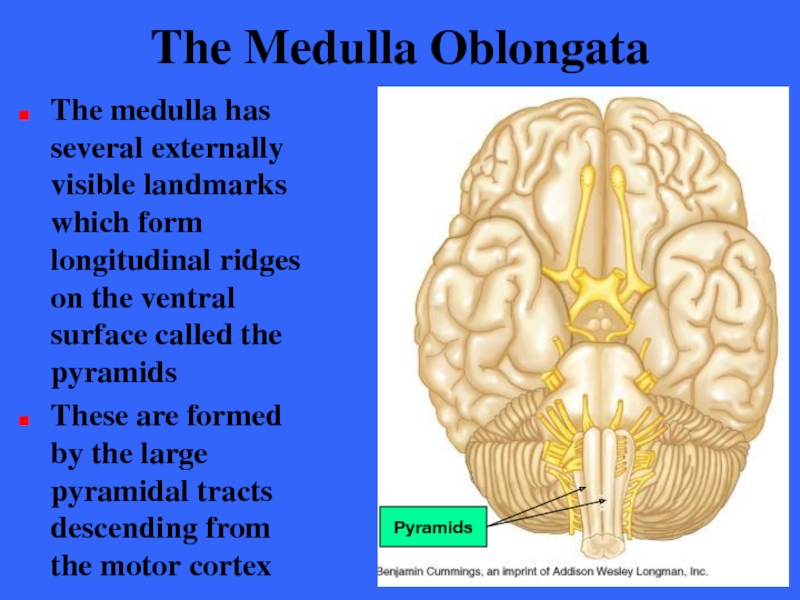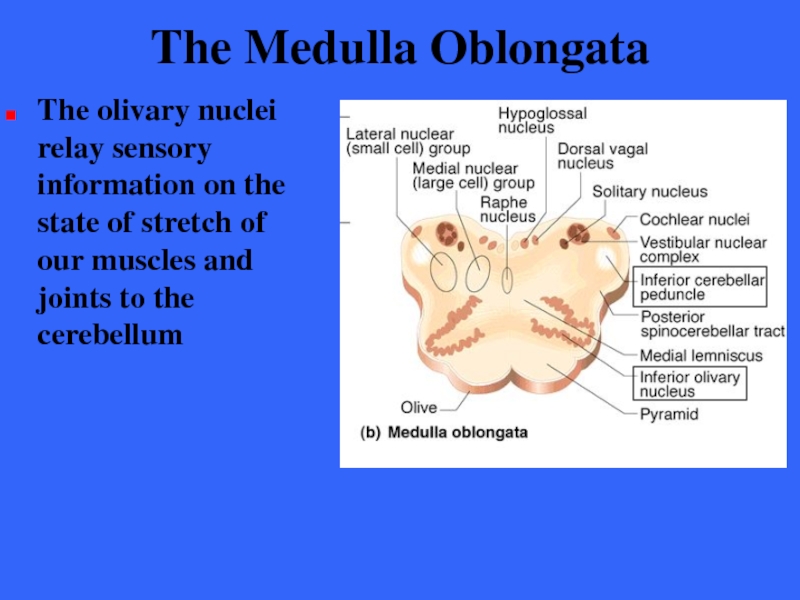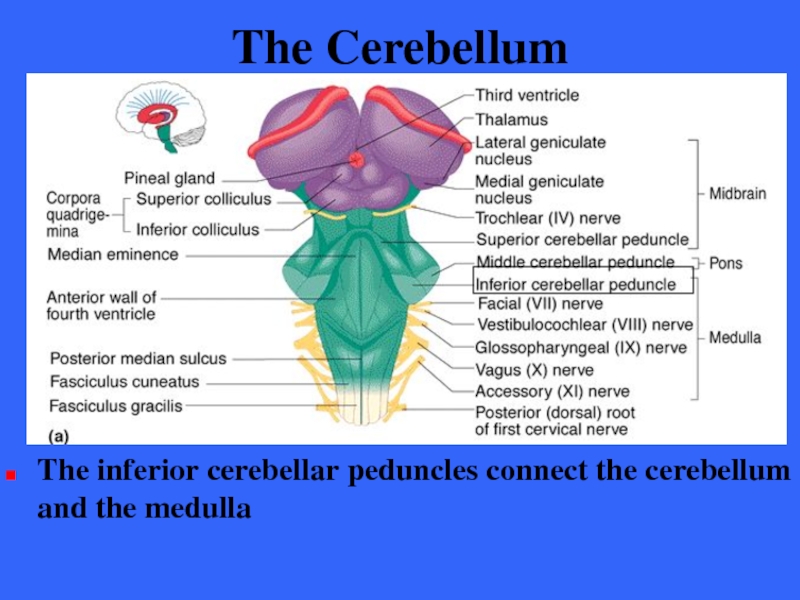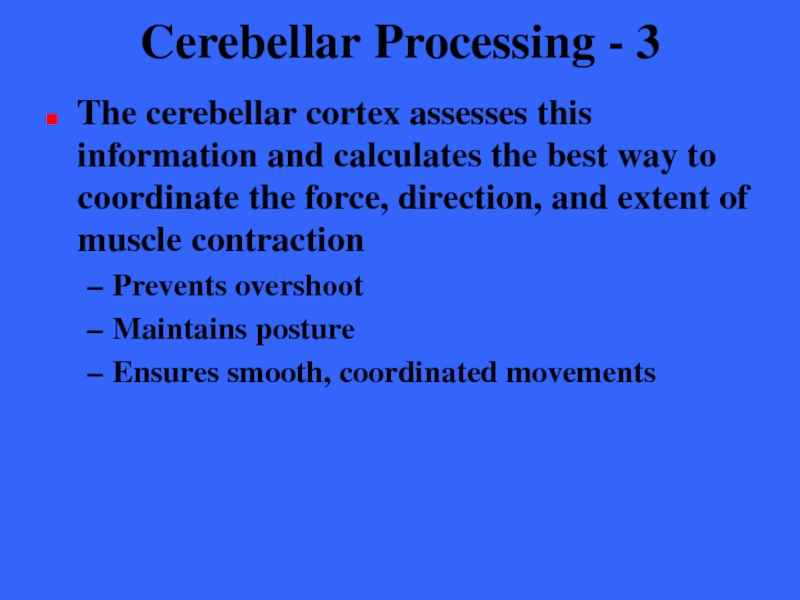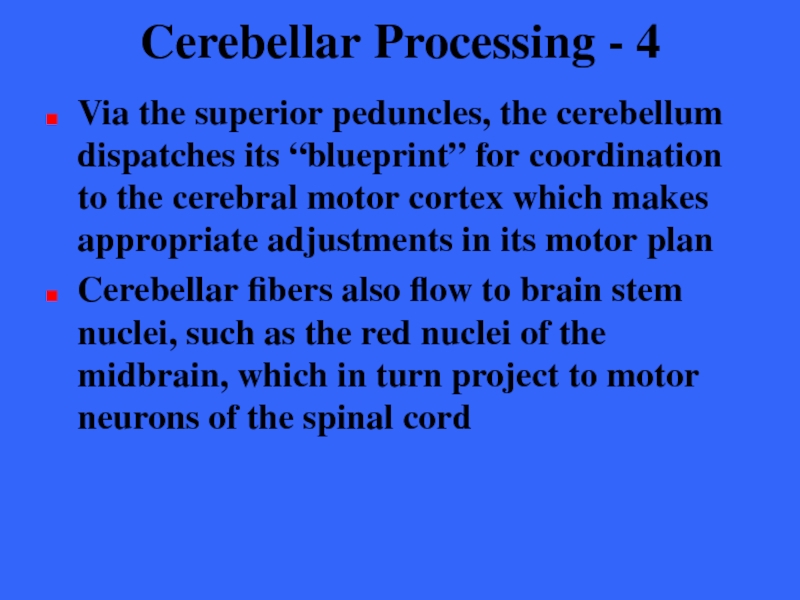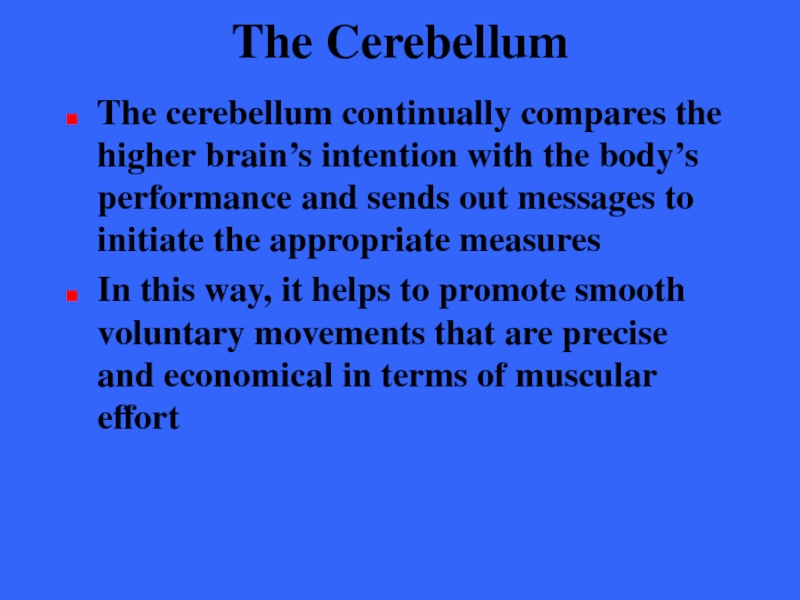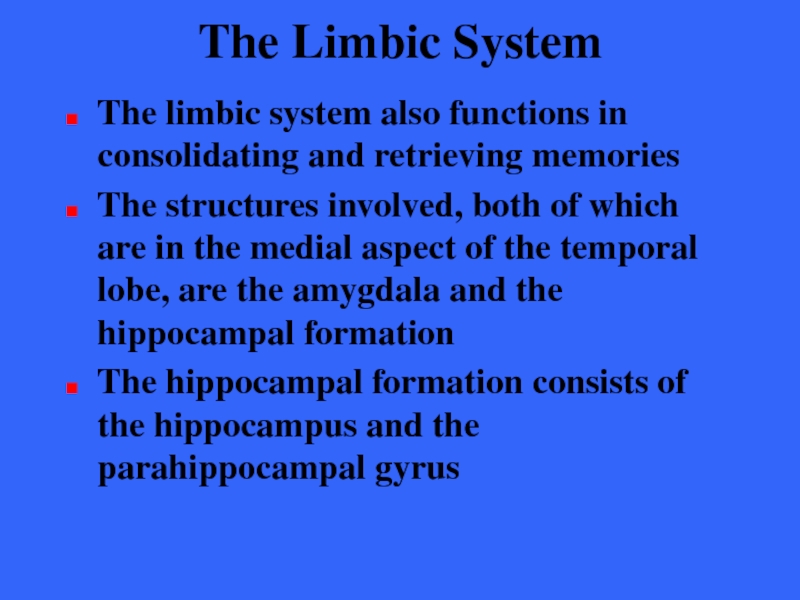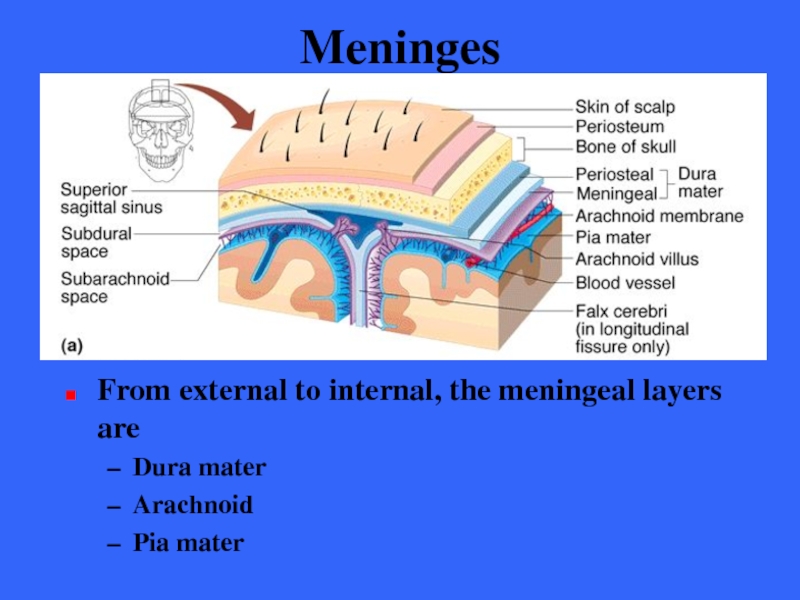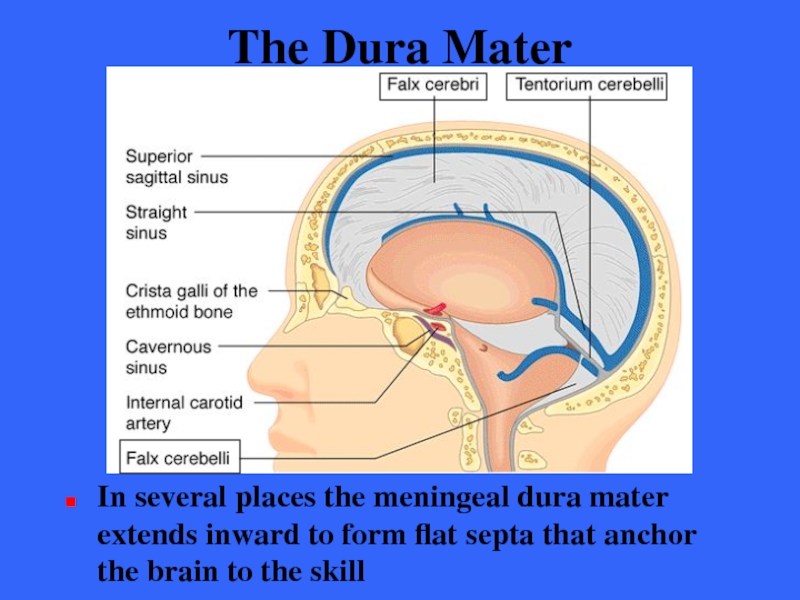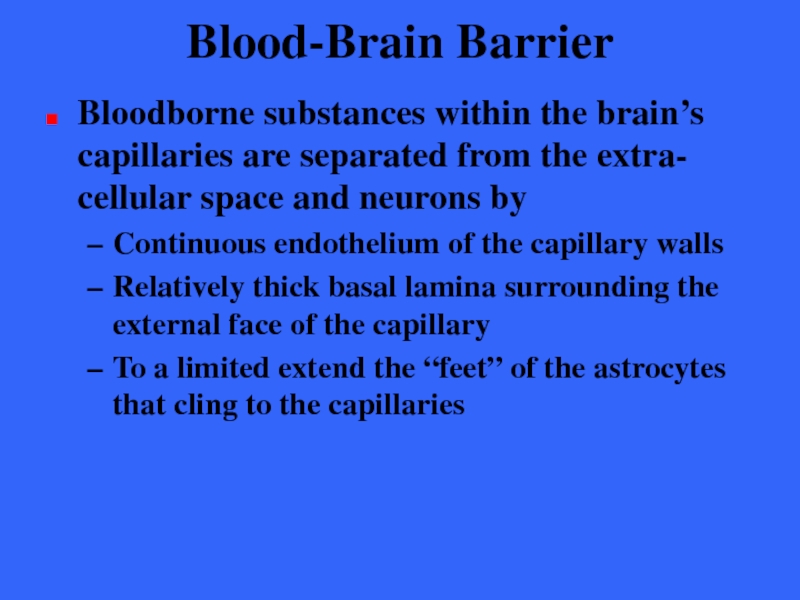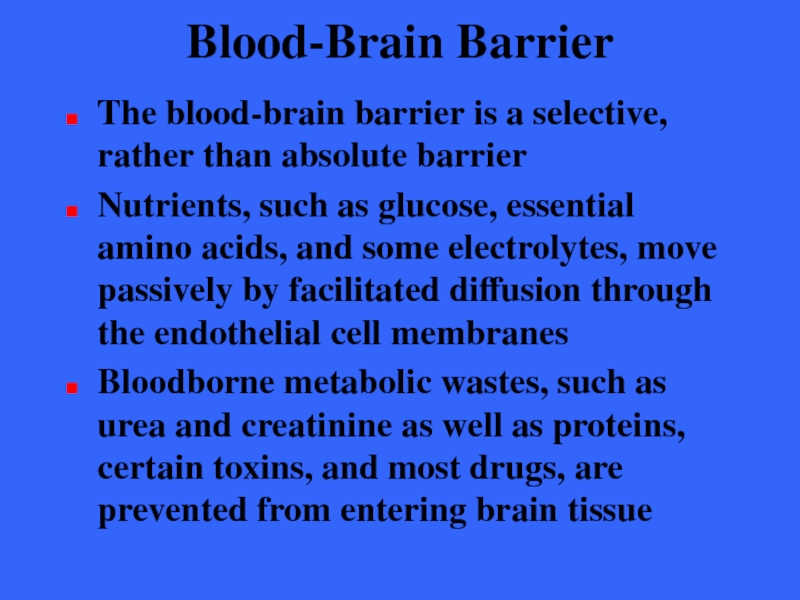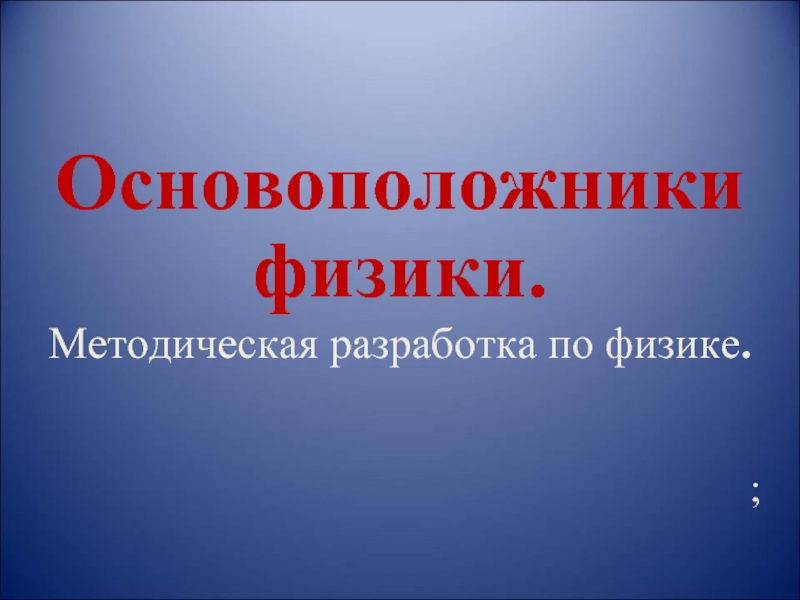Слайд 1Central Nervous System
Chapter 13
Слайд 2Introduction
Analogies; telephone switchboard; computer; miracle
A fantastically complex and flexible
biological organ
Cephalization become more apparent in higher order species
Increase
in the neurons at the rostral end of the CNS
Highest level of cephalization is found in humans
Слайд 3The Brain
The unimpressive appearance of the human brain give few
hints of its abilities
It is about two handfuls of delicate
pinkish gray tissue
Wrinkled surface
Consistency of cold oatmeal
Brain
stem
Cerebellum
Cerebral
hemisphere
Слайд 4The Brain
Average adult male’s brain weighs about 1600 g (3.5
pounds)
Average adult female’s brain weighs about 1450 g
Brain size
represents a proportional difference in body size
Brain size is not correlated to intelligence but is related to the complexity of the neural connections within the brain
Слайд 5Embryonic Development
Starting in the third week of pregnancy, the ectoderm
thickens along the dorsal midline axis of the embryo to
form a neural plate
The neural plate eventually gives rise to all neural tissues
Слайд 6Embryonic Development
The neural plate then invaginates, forming a groove flanked
by neural folds
Слайд 7Development of Neural Tube
As the groove deepens the superior edges
of the neural folds fuse, forming the neural tube
The tube
then detaches from the surface ectoderm and assumes a deeper position in the embryo
Слайд 8Development of Neural Tube
The neural tube is formed by the
fourth week of pregnancy and differentiates rapidly into the CNS
The
brain forms anteriorly and the spinal cord posteriorly
Слайд 9Development of Neural Tube
Small groups of neural fold cells migrate
laterally and locate between the surface ectoderm and the neural
tube to forming the neural crest
The neural crest gives rise to sensory neurons and some autonomic neurons destined to reside in ganglia
Слайд 10Development of Neural Tube
As soon as the neural tube is
formed, its anterior end begins to expand more rapidly than
the remaining portion
Слайд 11Primary Brain Vesicles
Constrictions in the neural tube appear to mark
off the three primary brain vesicles
Prosencephalon
(forebrain)
Mesencephalon
(midbrain)
Rhombencephalon
(hindbrain)
The remainder of the neural
tube becomes the spinal cord
Слайд 12Secondary Brain Vesicles
By the fifth week, the five brain regions
of the secondary brain vesicles are evident
The forebrain has divided
Telencephalon
Diencephalon
The midbrain remains undivided
The hindbrain has constricted to form
Metencephalon
Myelencephalon
Слайд 13Secondary Brain Vesicles
Each of the five secondary brain vesicles develops
rapidly to produce the major structures of the adult brain
The
greatest change occurs in the telencephalon which sprouts two large swellings which project anteriorly
These paired expansions become the cerebral hemispheres known collectively as the cerebrum
Hemispheres house ventricles
Слайд 14Secondary Brain Vesicles
Various areas of the diencephalon specialize to form
Hypothalamus
Thalamus
Epithalamus
Слайд 15Secondary Brain Vesicles
The mesencephalon develops into
Midbrain
Brain stem
Слайд 16Secondary Brain Vesicles
Various areas of the Metencephalon specialize to form
Brain
stem
Pons
Cerebellum
Слайд 17Secondary Brain Vesicles
Various areas of the Myelencephalon specialize to form
Brain
stem
Medulla oblongata
All the midbrain and hindbrain structures, with the exception
of the cerebellum, form portions of the brain stem
Слайд 18Adult Neural Canal Regions
The central canal of the neural tube
enlarge in four areas to form the fluid filled ventricles
Telencephalon
Lateral
ventricles
Superior portion of 3rd
Diencephalon
Most of third ventricle
Mesencephalon
Cerebral aqueduct
Metencephalon
Fourth ventricle
Myelencephalon
Fourth ventricle
Слайд 19Development of Flexures
During this period of rapid brain growth change
is also occurring in the relative position of its parts
Because the brain’s growth is restricted by the skull, midbrain and cervical flexures develop by the fifth week which bend the forebrain toward the brain stem
Слайд 20Effects of Space Restriction
A second consequence of restricted space is
that the cerebral hemispheres are forced to take a horseshoe
shaped course posteriorly and laterally
Development of the cerebral hemispheres at 13 weeks
Слайд 21Effects of Space Restriction
As a result the hemispheres grow back
over and almost completely envelop the diencephalon and midbrain
The cerebral
hemispheres at 26 weeks
Слайд 22Effects of Space Restriction
Continued growth of the cerebral hemispheres causes
their surfaces to crease and fold
Folding results in convolutions which
increase surface area and allow some 1012 neurons to occupy the limited space within the skull
Слайд 23Effects of Space Restriction
The wrinkling of the hemispheres may result
from tension on the young axons as they become arranged
in a way that minimizes the length of the interconnections they form among the various parts of the cerebrum
Слайд 24Regions of the Brain
The four main regions of the brain
are:
Cerebral hemi- spheres
Diencephalon
Thalamus
Hypothalamus
Epithalamus
Brain stem
Midbrain
Pons
Medulla
Cerebellum
Слайд 25Gray and White Matter in CNS
The basic pattern of the
CNS can be seen in the spinal cord
A central cavity
surrounded by a gray matter core of brain nuclei, external to which is white matter (myelinated fiber tracts)
Figure 12.29 presents major ascending and descending fiber tracts
Слайд 26Gray and White Matter in CNS
The brain has the same
basic design except that it also contains additional regions of
gray matter that are not evident in the spinal cord
Both the cerebral hemispheres and the cerebellum have an outer layer or cortex of gray matter consisting of neuron cell bodies
Слайд 27Gray and White Matter in CNS
The pattern of white and
gray matter changes with descent through the brain stem
The cortex
disappears, but scattered gray matter nuclei are seen within the white matter
At the caudal end of the brain stem the basic pattern is evident
Слайд 28Ventricles of the Brain
The ventricles of the brain arise from
the expansion of the neural tube
They are continuous with each
other and with the central canal of the spinal cord
Слайд 29Ventricles of the Brain
The hollow ventricular chambers are filled with
cerebrospinal fluid and lined by ependymal cells
Слайд 30Ventricles of the Brain
The paired lateral ventricles are large C-shaped
chambers that reflect the pattern of cerebral growth
One lateral
ventricle is located in each cerebral hemisphere
Слайд 31Ventricles of the Brain
Anteriorly, the lateral ventricles lie close together
separated only by a thin median membrane called the septum
pellucidum
Each ventricle communicates with the narrow third ventricle in the diencephalon
Слайд 32Ventricles of the Brain
Communication occurs through the inter- ventricular foramen
(foramen of Moro)
Слайд 33Ventricles of the Brain
The third ventricle is continuous with the
fourth ventricle via the canal-like cerebral aqueduct that runs through
the midbrain
Слайд 34Ventricles of the Brain
The fourth ventricle which lies dorsal to
the pons and posterior to the medulla, is continuous with
the central canal of the spinal cord inferiorly
Pons
Слайд 35Ventricles of the Brain
Three openings mark the walls of the
fourth ventricle
Paired lateral apertures
Median aperture
Apertures connect the ventricles to the
subarachnoid space
Pons
Subarachnoid space is filled with
cerebrospinal fluid to surround the brain
Слайд 36The Cerebral Hemispheres
The cerebral hemispheres form the superior part of
the brain
These two structures account for about 83% of the
mass of the brain
The two hemispheres cover and obscure the diencephalon and the top of the brain stem
Слайд 37The Cerebral Hemispheres
Nearly the entire surface of the cerebral hemispheres
is marked by elevated ridges of tissues called gyri separated
by shallow grooves called sulci
Deeper grooves called fissures separate larger regions of the brain
Слайд 38The Cerebral Hemispheres
Prominent gyri and sulci are similar in all
people
The median longitudinal fissure separates the hemispheres
The transverse fissure separates
the cerebral hemispheres from the cerebellum below
Слайд 39Lobes of Cerebral Hemispheres
Deeper sulci divide each hemisphere into five
lobes
Frontal lobe
Temporal lobe
Parietal lobe
Occipital lobe
Insula (located within the lateral sulcus)
Insula
Слайд 40Lobes of Cerebral Hemispheres
Location of the insula deep within the
Lateral sulcus of the hemisphere
Insula
Слайд 41Fissures of Cerebral Hemispheres
Sulci divide lobes of the hemispheres
Central
sulcus
Parieto- occipital sulcus
Lateral sulcus
Transverse fissure
Слайд 42Medial Surface of Right Hemisphere
Medial surface of the right hemisphere
showing the Parieto- occipital sulcus
Слайд 43Position of Cerebral Hemispheres
The frontal lobes occupy the anterior cranial
fossa
The anterior parts of the temporal lobes fill the middle
cranial fossa
The cerebellum and brain stem occupies the posterior cranial fossa and the occipital lobes rests upon it
Слайд 44Cerebral Cortex
The cerebral cortex is the “executive suite” of the
nervous system
It enables us to perceive, communicate, remember, understand, appreciate,
and initiate voluntary movements
Literally all qualities associated with conscious behavior or consciousness originate within the cerebral cortex of the various lobes of the brain
Слайд 45Cerebral Cortex
The cerebral cortex is gray matter composed of neuron
cells bodies, dendrites, and unmyelinated axons (plus support cells and
blood vessels)
It is only 2-4 mm thick
The many convolutions of the brain effectively triple its surface area
It accounts for roughly 40% of total brain mass
Слайд 46Cerebral Cortex
The cerebral cortex accounts for roughly 40% of total
brain mass
The cortex contains billions of neurons arranged in six
layers
Ana
Слайд 47Cerebral Hemispheres
Coronal section of the brain which reveals the cerebral
cortex, white matter, and basal nuclei within the cerebral hemispheres
Слайд 48Cerebral Cortex
Research on the structure and function of the brain
reveals that there are both specialized and diffuse areas of
function
Motor and sensory areas are localized in discrete cortical areas called domains
Many higher mental functions such as memory and language appear to have overlapping domains and are more diffusely located
Broadmann areas are areas of localized function
Слайд 49Cerebral Cortex - Generalizations
The cerebral cortex has three types of
functional areas
Motor areas / control voluntary motor function
Sensory areas /
provide conscious awareness of sensation
Association areas / act mainly to integrate diverse information for purposeful action
Each hemisphere is chiefly concerned with the sensory and motor functions of the opposite (contralateral) side of the body
Слайд 50Cerebral Cortex - Generalizations
Although they are largely symmetrical in structure
the two hemispheres are not entirely equal in function, instead
there is lateralization of cortical function
Remember that the information presented is a gross oversimplification to convey and clarify concepts
Слайд 51Motor Areas
Cortical areas controlling motor functions lie in the posterior
part of the frontal lobes
Motor areas include the primary motor
cortex, the premotor cortex, Broca’s area, and the front eye field
Слайд 52Primary Motor Cortex
The primary motor cortex is located in the
precentral gyrus of the frontal lobe of each hemisphere
Large neurons
(pyramidal cells) in these gyri allow us to consciously control the precise or skill voluntary movements of our skeletal muscles
Слайд 53Pyramidal cells
These long axons, which project to the spinal cord,
form the massive voluntary motor tracts called the pyramidal, or
corticospinal tracts
All other descending motor tracts issue from brain stem nuclei and consists of chains of two, three, or more neurons
Dendrites
Table 11.1
Слайд 54Pyramidal Tracts
The lateral corticospinal tract consists of the long axons
of the pyramidal cells located within the primary motor cortex
Слайд 55Motor Somatotopy
Body is represented spatially in the primary motor
cortex of each hemisphere
Most of the neurons in these gyri
control muscles in body areas having the most precise motor control
The areas with the most control (face, tongue, and hands)
Слайд 56Motor Somatotopy
Motor innervation is contralateral; left primary motor controls
right side of body
The image is useful to conceptualize areas
of synergistic function
However, a given muscle may be controlled by several cortical neurons recruited for several specific actions
Слайд 57Motor Somatotopy
Damage to the localized areas of the primary
motor cortex paralyzes the muscles controlled by this area
If the
lesion is in the right hemisphere, the left side will be paralyzed
Only voluntary control is lost as the muscles can still contract reflexively
Слайд 58Premotor Cortex
The premotor cortex controls motor skills of repetitive or
patterned nature (typing or piano)
The premotor cortex coordinates the movement
of several muscle groups to act simultaneously or sequentially
Слайд 59Premotor Cortex
The premotor cortex sends activating impulses to the primary
motor cortex
Also influences motor actively more directly by supplying about
15% of pyramidal tract fibers
A memory bank of skilled motor activities
Слайд 60Premotor Cortex
This area appears to involved with motor planning
It controls
voluntary actions that depend on sensory feedback
Слайд 61Premotor Cortex
Damage to the premotor area results in the loss
of the motor skills in that region
Muscle strength and the
ability to perform the discrete individual movements are not hindered
Neurons relearning the skill would require practice
Слайд 62Broca’s area
The area has long been considered to be present
in only one hemisphere (usually left)
A special motor speech area
that directs the muscles of the tongue, throat, and lips in articulating words
Слайд 63Broca’s area
Recent PET scans indicates that Broca’s area and a
similar area in the opposite hemisphere become active as we
prepare to speak
The areas may be involved with planning speech and other voluntary motor activities
Слайд 64Frontal Eye Field
This cortical region controls the voluntary movements of
the eyes
Engaged when we look quickly at something, as in
moving our eyes to follow a moving target
Слайд 65Sensory Areas
Areas concerned with the conscious awareness of sensation in
the parietal, temporal and occipital lobes
Слайд 66Primary Somato-sensory Cortex
Primary somato- sensory area resides in the
postcentral gyrus of the parietal lobe
Neurons in this gyrus receive
information relayed via a three neuron synaptic chain from general sensory receptors in the skin and proprio- ceptors in muscles
Слайд 67Synaptic Chain
Central axons of sensory (1st order) neurons enter dorsal
root of spinal cord
Synapse with 2nd order neurons in medial
lemniscal tract and ascend to Thalamus
Synapse with 3rd order neurons which transmit to somato- sensory cortex
Слайд 68Primary Somato-sensory Cortex
In the cortex neurons process the sensory
information and identify the precise area of the body being
stimulated
This ability to localize (assign a location) a stimulus precisely is called spatial discrimination
Слайд 70Primary Somato-sensory Cortex
The sensory spatial discrimination is contralateral with the
right hemisphere receiving inputs from the left side of the
body
The entire body is represented spatially in the primary somatosensory area of each hemisphere
Слайд 71Primary Somato-sensory Cortex
The amount of sensory cortex devoted to a
particular body region is related to how many sensory receptors
are present
In humans the face (especially the lips) and fingertips are the most sensitive body areas
Слайд 72Primary Somatosensory Cortex
Damage to the primary somatisensory cortex destroys the
conscious ability to feel and localize touch, pressure, and vibrations
on the skin
Most ability to feel pain and temperature is also lost, although these can still be felt in a vague, poorly localized way
Слайд 73Somatosensory Association Area
The area lies just posterior to the primary
somata- sensory cortex and has many connections with it (Broadmann
5,7)
The major function of the area is to integrate and analyze different somatic sensory inputs (touch, pressure, others) relayed to it by the primary somato- sensory cortex
Слайд 74Somatosensory Association Area
The somatosensory association area forms a comprehensive evaluation
of what is being felt relative to its size, texture
and parts
The somatosensory association area draws upon stored memories of past sensory experiences to perceive the object as one you recognize
Слайд 75Somatosensory Association Area
Past associations allow you to recognize familiar objects
(coins, keys) without having to look at them
Someone with damage
to this area would not be able to recognize what they are feeling without actually looking at the object
Слайд 76Primary Visual Cortex
The primary visual cortex (17) is located on
the posterior and medial portions of the occipital lobe
Слайд 77Primary Visual Cortex
Most of the primary visual cortex is located
on the medial aspect of the occipital lobe buried within
the deep calcarine sulcus
Слайд 78Primary Visual Cortex
The largest of all cortical sensory areas, the
primary visual cortex receives visual information that originates on the
retinas of the eyes
There is a map of visual space on the primary visual cortex analogous to the body map of the somato- sensory cortex
Слайд 79Primary Visual Cortex
Again, the right half of visual space is
represented on the left visual cortex, the left half on
the right cortex
If this cortical area is damaged, the person has no conscious awareness of what is being viewed and is functionally blind
Слайд 80Primary Visual Cortex
The primary visual cortex is the first of
a series of cortical areas that process visual input
The processing
here is at a comparatively low level - noting the orientation of objects being viewed and putting the inputs from the two eyes together
Слайд 81Visual Association Area
This area surrounds the primary visual area and
encompasses much of the occipital lobe (18, 19)
Communicating with the
primary visual area, the visual association area continues the processing of visual information
Слайд 82Visual Association Area
This area analyzes color, form and movement in
light of past visual experiences so that we might recognize
& appreciate what we are seeing
Слайд 83Visual Association Area
Recent neuroimaging has revealed that complex visual processing
far forward from the occipital lobe into the temporal and
parietal lobes
Overall, about 30 cortical areas for visual processing have been identified, with each more sophisticated than the last
The visual information proceeds anteriorly through these visual areas in two streams
Слайд 84Visual Association Area
The ventral stream extends through the inferior part
of the entire temporal lobe and is responsible for recognizing
objects, words during reading, and faces
Facial recognition is right hemisphere only
The “what”
Слайд 85Visual Association Area
The dorsal stream extends through the posterior parietal
cortex to the postcentral gyrus and perceives spatial relationships among
different objects
The “where” things are in space
Слайд 86Visual Association Area
The dorsal stream in the parietal lobe is
important for spatial perception
The superior part of the lobe calculates
how we move our limbs through space then sends this information to the motor cortex which dictates these movements
In addition, the parietal lobe is important for abstract mathematical abilities, which are highly visual, spatial in nature
Слайд 87Visual Areas
Damage to the visual cortex results in functional blindness
Damage
to the visual association areas results in an ability to
see but not comprehend what is seen
Слайд 88Primary Auditory Cortex
The primary auditory cortex is located on the
superior margin of the temporal lobe, primarily inside the lateral
sulcus
Broadmann 41,42
It provides us with our conscious awareness of sound
Слайд 89Primary Auditory Cortex
Hearing receptors in the cochlear of the inner
ear transmit impulses to primary auditory cortex
Impulses related to loudness,
rhythm, and especially pitch (high to low notes) is complied
Слайд 90Auditory Association Area
The auditory association area lies just posterior to
the primary auditory area Broadmann 22
This area evaluates and classifies
sound
Memories of past sounds seem to be stored here
Слайд 91Auditory Association Area
In one hemisphere (usually the left), the auditory
association areas lies in the center of Wernicke’s area
This functional
area is involved in recognizing and understanding spoken words
Слайд 92Auditory Association Area
Damage to Wernicke’s area interferes with the ability
to comprehend speech
Слайд 93Gustatory (taste) Cortex
The gustatory cortex is involved in the conscious
awareness of tase stimuli
Broadmann 43
It lies on the roof of
the lateral sulcus
This taste area occurs on the tongue in the somatosensory homunculus
Слайд 94Vestibular (equilibrium) Cortex
The cortex is responsible for conscious aware-ness of
the sense of balance; specifically the position of the head
in space
Recent studies have placed this region in the posterior insula deep in the lateral sulcus
Слайд 95Olfactory Area
The primary olfactory cortex lie on the medial aspects
of the cerebrum in a small region called the piriform
lobe of which the hook-like uncus is the dominant feature
Слайд 96Olfactory Area
The olfactory nerves (Cranial nerve I) from the nasal
cavity transmit impulses that are ultimately relayed to the olfactory
cortex
The outcome is conscious awareness of smells
Слайд 97Olfactory Area
The olfactory cortex is part of a brain area
called the rhinencephalon (nose brain) which includes all parts of
the cerebrum that directly receive olfactory signals
Слайд 98Olfactory Area
The piriform lobe, the olfactory tract, the olfactory bulb,
and some nearby structures are all components of the rhinencephalon
Слайд 99Olfactory Area
The rhinencephalon connects to the brain area that is
involved in emotions, the limbic system, which explains why smells
often trigger emotions
Слайд 100Olfactory Area
Part of the frontal lobe, the orbitofrontal cortex, is
involved in higher-order processing of smells
Consciously identifying and recalling specific
odors and telling different smells apart
Слайд 101Association Areas
Association areas include all cortical areas other than primary
sensory and motor areas
The name reflects the fact that some
of these areas tie together, or make associations between different kinds of sensory information
They also seem to associate new sensory inputs with memories of past experiences
Слайд 102Association Areas
The term association area is fading from use and
will probably be replaced by higher- order processing areas
Higher-order processing
areas is a more accurate name as these areas, which are nearby the primary sensory areas, have the ability to analyze, recognize, and act on the sensory input received
Слайд 103Prefrontal Cortex
The prefrontal cortex occupies the large region of the
frontal lobe anterior to the motor area
The most complicated cortical
region
It performs many cognitive functions
Слайд 104Prefrontal Cortex
Cognition is all aspects of thinking, perceiving and of
intentionally remembering and recalling information
The prefrontal cortex is necessary for
abstract ideas, reasoning and judgment, impulse control, persistence, long term planning
Слайд 105Prefrontal Cortex
The prefrontal cortex also is used for long- term
planning, complex problem solving, mental flexibility, social skills, appreciating humor,
empathy, and conscience
Слайд 106Prefrontal Cortex
The prefrontal cortex also seems to be related to
mood and has close links to the emotional (limbic) part
of the forebrain
Tumors in this region may cause mental and personality disorders
The tremendous elaboration of this prefrontal region distinguishes humans from animals
Слайд 107Prefrontal Cortex
Functional neuro-imaging techniques have begun to reveal the functions
of specific parts of the prefrontal cortex
Completion of multi-step problem
solving tasks requires the temporary storage of information in working memory
Слайд 108Prefrontal Cortex
The working memories of spatial relations are stored in
the dorsolateral prefrontal cortex just anterior to the frontal eye
field
Слайд 109Prefrontal Cortex
Working memories of objects and faces are stored farther
ventrally, below Broca’s area
Слайд 110Prefrontal Cortex
More significant is the region that manages cognitive tasks
by directing our attention to the relevant information in the
working memory
This executive area lies between the working- memory sites, just anterior to Broca’s area
Слайд 111Prefrontal Cortex
The extreme anterior pole of the frontal cortex was
found to be active in solving the most complex problems
- problems in which many sub- problems had to be completed before a solution could be obtained
Слайд 112Prefrontal Cortex
The new findings suggest support for a general rule
of neuroscience that says the farther rostrally one goes in
the CNS, the more complex are the neuron functions performed
Слайд 113Prefrontal Cortex
The area just anterior to the corpus callosum may
process emotions involved in “mentalization”, the ability to understand and
manipulate other people’s thoughts and emotions
Слайд 114General Interpretation Area
The existence of this area within the brain
is debated
Once thought to be an area of integration of
all types of sensory information, its existence was mainly substantiated by agnosia (not knowing)
Recent studies do not support its presence
Слайд 115Language Area
The large area surrounding the lateral sulcus in the
left cerebral hemisphere is involved in various functions related to
language
Слайд 116Language Area
Five areas have been identified with language; Broca’s area
(speech production); Wernicke’s area (speech comprehension); prefrontal cortex (conceptual analysis);
temporal lobe (visual and auditory aspects of language ); the insula (recognition of rhythms)
Слайд 117Language Area
The corresponding areas on the right hemisphere, although not
involved in the mechanics of language, act in the creative
interpretation of words and in controlling the emotional overtones of speech
Слайд 118Insula
The insula is large and the functions of its cortex
are not well understood
Some parts function in language and some
in the sense of balance
Other parts have visceral function including the perception of upset stomach, full bladder
Слайд 119Lateralization of Cortical Function
We use both cerebral hemispheres for almost
every task and it appears the hemispheres share memories and
appear nearly identical
However, there are differences and unique abilities that are found in one hemisphere and not the other
This phenomenon is call lateralization
Cerebral dominance suggest that there is one hemisphere that dominates each task
Слайд 120Lateralization of Cortical Function
In most people (Approx. 90%) the left
hemisphere has greater control over language abilities, mathematical abilities, and
logic
The other hemisphere (usually the right) is involved in visual-spatial skills, intuition, emotion, and appreciation of art and music
Слайд 121Lateralization of Cortical Function
Most individuals (90%) with left cerebral dominance
are right-handed
In the remaining 10% the roles of the hemispheres
are reversed or the hemispheres share their functions equally
Typically, many right cerebral dominant people are left handed and more often male
In lefties the cerebral cortex functions bilaterally, the mutuality of brain control sometimes result in ambidexterity or dyslexia
Слайд 122Lateralization of Cortical Function
The two cerebral hemispheres have perfect and
almost instantaneous communication with one another via connecting fiber tracts
as well as complete integration of their functions
Lateralization means that each hemisphere is better than the other at certain functions, neither side is better at everything
Слайд 123Cerebral White Matter
Communication within the brain is extensive
The cerebral white
matter deep to the gray matter of the cortex provides
for communication between cerebral areas and between the cortex and the lower CNS centers
Слайд 124Cerebral White Matter
The white matter largely consists of myelinated fibers
bundled into large tracts
These fibers and the tracts they form
are classified according to the direction in which they run as
Commissural
Association
Projection
Слайд 125Cerebral White Matter
Commissures connect the hemispheres
Association fibers connect areas within
hemispheres
Projection tracts connect higher & lower areas of CNS
Projection
Fibers
Commissure
Fibers
Слайд 126Cerebral White Matter
Commissures connect the corresponding areas of two hemispheres
enabling them to function as a whole
The Corpus callosum is
the largest commissure
Слайд 127Cerebral White Matter
Association fibers transmit within a single hemisphere
Short fibers
connect adjacent gyri or cortical areas
Long fibers are bundled into
tracts and connect different cortical lobes
Слайд 128Cerebral White Matter
Projection fibers run vertically to connect levels of
the CNS
Impulses from receptors and to effectors move within these
tracts
At the upper limits of the brain stem, the projection fibers on each side form a compact band called the internal capsule
Слайд 129Cerebral White Matter
Ascending projection tracts pass between the thalamus and
the basal nuclei beyond which the radiate through the cerebral
white matter to the cortex
This distinctive arrangement of projection tract fibers is called the corona radiata
Thalamus
Слайд 130Cerebral White Matter
The fibers of the corona radiata fan out
into the white matter of the cerebral hemisphere
Слайд 131Basal Nuclei
In the cerebral white matter of each hemisphere are
a groups of subcortical nuclei called the basal nuclei
The main
mass of this tissue include the caudate nucleus, putamen, and the globus pallidus
Слайд 132Basal Nuclei
The putamen and globus pallidus together form a mass
called the lentiform nucleus
Слайд 133Basal Nuclei
The comma shaped caudate nucleus arches superiorly over the
diencephalon
Слайд 134Basal Nuclei
The lentiform nucleus flanks the internal capsule laterally
Lentiform
nucleus
Слайд 135Basal Nuclei
Collectively the caudate nucleus and the lentiform nuclei are
called the corpus striatum because the fibers of the internal
capsule that course past these nuclei give them a striped appearance
Слайд 136Basal Nuclei
The basal nuclei are functionally associated with the subthalamic
nuclei (located in the floor of the diencephalon) and the
substantia nigra of the midbrain
Слайд 137Basal Nuclei
The amygdaloid nucleus sits on the tail of the
caudate nucleus, functionally it belongs to the limbic system
Слайд 138Basal Nuclei
Functionally, the basal nuclei can be viewed as complex
neural calculators that cooperate with the cerebral cortex in controlling
movement
Слайд 139Basal Nuclei
The basal nuclei receive inputs from the entire cerebral
cortex as well as from other subcortical nuclei
Via relays through
the thalamus, the basal nuclei project to the premotor and prefrontal cortices
Слайд 140Basal Nuclei
Via relays the basal nuclei influence muscle movements directed
by the primary motor cortex
The basal nuclei has no direct
access to the motor pathways
The precise role of the basal nuclei is difficult to determine since their function overlaps to some extent with the cerebellum
The basal nuclei are particularly important in starting, stopping, and monitoring movements executed by the by the cortex
Слайд 141Basal Nuclei
The nuclei are involved in monitoring muscle movements that
are relatively slow and sustained or patterned
The nuclei also regulated
the intensity of these movements
Additionally, they inhibit antagonistic or unnecessary movements
When the basal nuclei are impaired, the result is disturbances in posture and muscle tone, involuntary movements including tremors, and abnormal slowness
Слайд 142The Diencephanlon
Forms the central core of the forebrain and is
surrounded by the cerebral hemispheres
Слайд 143The Diencephalon
The diencephalon consists of three structures
Thalamus
Hypothalamus
Epithalamus
These structures effectively enclose
the third ventricle
Hypothalamus
Thalamus
Epithalamus
Слайд 144The Diencephalon
The three structures of the diencephalon
Thalamus
Hypothalamus
Epithalamus
These structures are
shown with the hemispheres removed
Слайд 145Thalamus
The egg shaped thalamus makes up 80% of the diencephalon
and forms the superolateral walls of the third ventricle
Слайд 146Thalamus
The thalamus is composed of bilateral masses of gray matter
held together by a mid- line commissure called the intermediate
mass
Thalamus
Third
Ventricle
Intermediate
mass
Слайд 147Thalamus
The thalamus has many different nuclei, most named for their
location
Each of these nuclei has a functional specialization
Each projects fibers
to and receives fibers from a specific region of the cerebral cortex
Слайд 148The Thalamus
Sensory inputs are not the only type of information
relayed through the thalamus
Every part of the brain that communicates
with the cerebral cortex must relay signals through the nucleus of the thalamus
The thalamus can therefore be thought of as the gateway to the cerebral cortex
Слайд 149Thalamus
Afferent impulses from all senses and all parts of the
body converge on the thalamus and synapse with at least
one of its nuclei
Within the thalamus, a sorting-out and information “editing” process occurs
Слайд 150Thalamus
Impulses having to do with similar functions are grouped together
and relayed via the internal capsule to the appropriate area
of the sensory cortex as well as specific cortical association areas
Слайд 151Thalamus
In addition to sensory inputs, virtually all inputs ascending to
the cerebral cortex funnel through thalamic nuclei
Ventral posterior lateral nucleus
General
somatic sensory receptors (touch, pain pressure)
Слайд 152Thalamus
Lateral geniculate body
Visual relay from retina
Medial geniculate body
Auditory inputs
Anterior nuclear
group
Regulation of emotion and visceral function
Ventral lateral nuclei
Direct motor activity
of cerebellum
Ventral anterior nuclei
Direct motor activity of basal nuclei
Слайд 153Thalamus
Pulvinar, medial dorsal and lateral nuclei are involved in the
integration of sensory information and projection to specific association cortices
Слайд 154Thalamus
The thalamus plays a key role in mediating sensation, motor
activities, cortical arousal, learning, and memory
It is truly the gateway
to the cerebral cortex
Слайд 155The Hypothalamus
The hypothalamus is located below the thalamus, capping the
brain stem
Hypothalamus
Слайд 156Hypothalamus
Merging into the midbrain inferiorly, it extends from the optic
chiasma to the posterior margin of the mammillary bodies
Mammillary
bodies
Optic
chiasma
Слайд 157Mammillary Bodies
The mammillary bodies are paired nuclei that bulge anteriorly
from the hypothalamus that serve as relay stations in the
olfactory pathways
Слайд 158Hypothalamus
Between the optic chiasma and the mammillary bodies is the
infundibulum
A stalk of the hypothalamic tissue connects the pituitary gland
to the base of hypothalamus
Слайд 159Hypothalamus
The hypothalamus contains about a dozen functionally important nuclei
Despite its
small size, the hypothalamus is the main visceral control center
of the body and is vitally important to overall body homeostasis
Слайд 160Autonomic Control Center
The hypothalamus regulates involuntary nervous activity by controlling
the activity of autonomic centers in the brain stem and
spinal cord
In this role the hypothalamus influences
Blood pressure
Rate and force of heart contraction
Motility of the digestive system
Respiratory rate and depth
Secretion of sweat and salivary glands
Слайд 161Center for Emotional Response
The hypothalamus has numerous connections with cortical
association areas, lower brain stem centers, and it lies at
the center of the limbic system which is the emotional part of the brain
Nuclei involved in the perception of fear, pleasure, and rage, as well as those involved in the biological rhythms and drives of sex are found in the hypothalamus
Слайд 162Center for Emotional Response
The hypothalamus acts through the autonomic nervous
system to initiate most physical expressions of emotion
Physical manifestations of
fear
Pounding heart
Elevated blood pressure
Pallor
Sweating
Dry mouth
Слайд 163Body Temperature Regulation
The body’s thermostat is in the hypothalamus
The hypothalamus
receives input from the thermoreceptors located in other parts of
the brain as well as in the body periphery
Homeostatic adjustments are then made to either cool or heat the body (sweating or shivering)
Hypothalamic centers also induce fever
Слайд 164Body Temperature Regulation
Hypothalamic receptors in the preoptic region monitor the
temperature of the blood flowing through the hypothalamus
Слайд 165Body Temperature Regulation
According to signals received by the preoptic nuclei
the hypothalamus initiates mechanisms to maintain relatively constant body temperature
Cooling / sweating
Heat generation / shivering
Слайд 166Regulation of Hunger & Thirst
In response to changing levels of
glucose, amino acids, hormones, and salts in the blood, the
hypothalamus regulates feelings of hunger and satiety (ventro- medial nuclei)
Слайд 167Regulation of Water Balance
When body fluids become too concentrated, hypothalamic
neurons called osmoreceptors are activated
These receptors excite hypothalamic nuclei that
trigger the release of antidiuretic hormone (ADH) from the posterior pituitary
ADH causes the kidneys to retain water
The same conditions also stimulate hypothalamic neurons in the thirst center, causing us to drink fluids
Слайд 168Regulation of Sleep-Wake Cycles
Acting with other brain regions, the hypothalamus
helps regulate the complex phenomenon of sleep
It is responsible for
the timing of the sleep wake cycle
Слайд 169Regulation of Sleep-Wake Cycles
Hypothalamus through the operation of its suprachiasmatic
nucleus (our biological clock) sets the timing of the sleep-wake
cycle in response to day-light darkness cues from visual pathways
Слайд 170Control of Endocrine Functioning
The hypothalamus acts as the helmsman
of the endocrine system
By producing releasing hormones, it controls the
secretion of hormones by the anterior pituitary gland
The supraoptic and paraventricular nuclei produce hormones (ADH and oxytocin)
Слайд 171Formation of Memory
The nucleus of the mammillary body receives many
inputs from the major memory-processing structures of the cerebrum, the
hippocampal formation and therefore may relate to memory formation
Слайд 172Epithalamus
The epithalamus is the posterior portion of the diencephalon
It forms
the roof of the third ventricle
Epithalamus
Слайд 173The Epithalamus
The epithalmus consists of one tiny group of nuclei
and a small, unpaired knob called the pineal body
This gland,
which derives from ependymal glial cells, is a hormone secreting organ
Слайд 174Epithalamus
The pineal gland extends from the posterior border of the
epithalamus
The pineal gland secretes the hormone melatonin which signals
the sleep- wake cycle
Pinal
Body
Слайд 175The Epithalamus
A cerebrospinal fluid-forming structure called a choroid plexus is
also part of the epithalamus
Choroid
Plexus
Слайд 176The Brain Stem
The third of the four major parts of
the brain is the brain stem
From superior to inferior, the
brain stem is divided into;
Midbrain
Pons
Medulla oblongata
Midbrain
Pons
Medulla
oblongata
Слайд 177The Brain Stem
Each region is roughly an inch long
Together than
constitute 2.5% of total brain mass
The brain stem has several
functions
It produce the rigidly programmed, automatic behaviors necessary for our survival
Acts as a passageway for all the fiber tracts running between the cerebrum and spinal cord
It is heavily involved with the innervation of the face and head as 10 of the 12 cranial nerve attach to it
Слайд 178The Brain Stem
The brain stem has the same structural plan
as the spinal cord, with outer white matter surrounding an
inner region of gray matter
However, there are also nuclei of gray matter located within the white matter
Слайд 179The Midbrain
The midbrain is located between the diencephalon superiorly and
the pons inferiorly
Слайд 180The Midbrain
Its central cavity is the cerebral aqueduct, which divides
it into a tectum (dorsal surface) and paired cerebral peduncles
From
an anterior view the cerebral peduncles appear as columns that hold up the cerebrum
Слайд 181The Midbrain
These peduncles contain the pyramidal (corticospinal) motor tracts descending
toward the spinal cord
The ventral part of each peduncle contains
the tract called the crus cerebri
Слайд 182The Midbrain
Dorsally, the midbrain has the superior cerebellar peduncles which
connect midbrain to the cerebellum
Слайд 183The Midbrain
Surrounding the cerebral aqueduct is the peri-aqueductal gray matter
that has two somewhat related functions
Слайд 184The Midbrain
The periaqueductal gray matter is involved in the “fright-and-flight”
sympathetic reaction
The gray matter is a link between the amygdala
of the forebrain (which perceives fear) and the autonomic pathway (which directly signals the physiological reactions associated with fear)
Слайд 185The Midbrain
The gray matter elicits
A terror-induced increase in heart
rate
Skyrocketing blood pressure
Wild fleeing or defensive freezing
The flexing of
the spine as in curling into a ball for protection
The suppression of pain upon injury
Слайд 186The Midbrain
The periaqueductal gray matter also seems to mediate our
response to visceral pain (as when nauseous) during which it
Decreases heart rate and blood pressure
Produce a cold sweat
Discourages movement
Слайд 187The Midbrain
The most ventral part of the para- aqueductal gray
mattercontains cell bodies of motor neurons that contribute to two
cranial nerves
Oculomotor (III)
Trochlear (IV)
These cranial nerves control most muscles that move the eyes
Слайд 188The Midbrain
Nuclei are also scattered in the surrounding white matter
The
largest of these nuclei are the corpora quadrigemia which raise
four dome like protrusions on the dorsal midbrain surface
Corpora
quadrigemia
Слайд 189The Midbrain
The superior pair of nuclei, the superior colliculus are
visual reflex centers that
coordinate head and eye movements when following
a moving object
Make us turn our head involuntarily when we detect movement in our peripherial vision
Superior
colliculus
Слайд 190The Midbrain
The inferior colliculus are part of the auditory relay
from the hearing receptors of the ear to the sensory
cortex
Act in reflexive response to sound as in the startle reflex
Turn your head toward unexpected source of sound
Inferior
Colliculus
Слайд 191The Midbrain
Also imbedded in the white matter of the midbrain
are two pigmented nuclei, the substantia nigra and the red
nucleus
Слайд 192The Midbrain
The substantia nigra is a bandlike nucleus located deep
to the cerebral peduncle
It is the largest nuclear mass in
the midbrain
Слайд 193The Midbrain
Its dark color reflects its high content of melanin
pigment, a precursor of dopamine a neurotransmitter released by these
neurons
The substantia nigra is functionally linked to the basal nuclei of the cerebral hemispheres
Слайд 194The Midbrain
The red nucleus is found between the substantia nigra
and the cerebral aqueduct
It reddish hue is due to its
vascular supply and the presence of iron pigment in the cell bodies of its neurons
Слайд 195The Midbrain
The red nuclei are relay nuclei in some descending
motor pathways that effect limb flexion
The red nuclei is the
largest nucleus in the reticular formation, a system of small nuclei scattered through the core of the brain stem
Слайд 196The Pons
The pons is the bulging brain stem region wedged
between the midbrain and the medulla oblongata
Pons
Слайд 197The Pons
It forms part of the anterior wall of the
fourth ventricle
It is chiefly composed of conduction tracts
The deep projection
fibers run longitudinally and complete the pathway between higher brain centers and spinal cord
Pons
Слайд 198The Pons
The deep projection fibers run longitudinally and complete the
superior-inferior pathway between the higher brain centers and the spinal
cord
Pons
Слайд 199The Pons
The more superficial nuclei are relays for conversations between
the motor cortex and the cerebellum
These fibers are orientated dorsally
and transversely and connect the pons bilaterally with the cerebellum
Middle
Cerebellar
peduncles
Слайд 200The Pons
Several cranial nerves issue from pons nuclei
Trigeminal nerve
Abducens
nerve
Facial nerves
Слайд 201The Pons
Other important pons nuclei are part of the reticular
formation
The pneumotaxic center is a respiratory center
Functioning with medullary respiratory
centers it helps to maintain the normal rhythm of breathing
Слайд 202The Medulla Oblongata
The medulla oblongata is the most inferior part
of the brain stem
Medulla
oblongata
Слайд 203The Medulla Oblongata
The medulla blends into the spinal cord at
the level of the foramen magnum
The central canal of the
spinal cord continues upward into the medulla where it broaden to form the fourth ventricle
Слайд 204The Medulla Oblongata
The medulla has several externally visible landmarks which
form longitudinal ridges on the ventral surface called the pyramids
These
are formed by the large pyramidal tracts descending from the motor cortex
Pyramids
Слайд 205The Medulla Oblongata
Just above the medulla-spinal cord junction most of
the fibers cross over to the opposite side before continuing
their descent into the spinal cord
The crossover point is called the decussation of the pyramids
Decussation
Of pyramids
Слайд 206The Medulla Oblongata
The consequence of this crossover is that each
hemisphere chiefly controls the voluntary movements of muscles on the
opposite or contralateral side of the body
Decussation
Of pyramids
Слайд 207The Medulla Oblongata
The inferior cerebellar peduncles are fiber tracts that
connect the medulla to the cerebellum dorsally
The olives are oval
swellings produced by the underlying inferior olivary nuclei
Слайд 208The Medulla Oblongata
The olivary nuclei relay sensory information on the
state of stretch of our muscles and joints to the
cerebellum
Слайд 209The Medulla Oblongata
The rootlets of the hypoglossal nerves emerge from
the groove between the pyramid and olive on each side
of the brain stem
Слайд 210The Medulla Oblongata
Other cranial nerves associated with the medulla are
the Glossopharyngeal, Vagus, and portions of the Accessary nerves
Слайд 211The Medulla Oblongata
The fibers of the vestibulocochlear synapse with the
cochlear nuclei which receive information on auditory inputs
Слайд 212The Medulla Oblongata
Also housed within the medulla are several nuclei
associated with ascending sensory tracts
The most dominant of these are
the dorsally located nucleus gracilis and nucleus cuneatus associated with the medial lemniscal tract
Слайд 213Medulla
Oblongata
These serve as relay nuclei in a pathway by
which general somatic sensory information ascends from the spinal cord
to the somatosensory cortex
Слайд 214The Medulla Oblongata
The medulla has a critical role as an
autonomic reflex center involved in maintaining body homeostasis
The cardiovascular center
The
respiratory centers
Other centers
Слайд 215The Medulla Oblongata
The cardiac center
The cardiac center adjusts the force
and rate of heart contraction to meet bodily needs
Слайд 216The Medulla Oblongata
The vasomotor center
The vasomotor center regulates blood pressure
by acting on smooth muscle in the walls of the
blood vessels to effect changes in blood vessel diameter
Vasoconstriction causes blood pressure to rise; dilation reduces blood pressure
Слайд 217The Medulla Oblongata
The respiratory centers
The medullary respiratory centers control the
rate and depth of breathing and maintains respiratory rhythm
Слайд 218The Medulla Oblongata
Other centers
Additional centers regulate activities such as
Vomiting
Hiccuping
Swallowing
Coughing
Sneezing
Слайд 219The Medulla Oblongata
Many functions of the medulla overlap with those
attributed to the hypothalamus
The overlap is easily explained
The hypothalamus exerts
its control over most visceral functions by relaying its instructions through the medulla’s reticular centers (within the Medulla oblongata) which carry them out
Слайд 220The Cerebellum
The cerebellum is exceeded in size only by the
cerebrum
It accounts for about 11% of total brain mass
Слайд 221The Cerebellum
The cerebellum is located dorsal to the pons and
medulla under the occipital lobe of the cerebral hemispheres
Cerebellum
Слайд 222The Cerebellum
It is separated from the occipital lobe by the
transverse fissure
It rests in the posterior cranial fossa of the
skull
Слайд 223The Cerebellum
The cerebellum processes inputs received from
Cerebral motor cortex
Various
brain stem nuclei
Sensory receptors
The cerebellum provides precise timing and appropriate
patterns of skeletal muscle contraction
Need for the smooth, coordinated movements of daily living
Cerebeller activity occurs subconsciously; we have no awareness of its functioning
Слайд 224The Cerebellum
The cerebellum is bilaterally symmetrical
Its two cerebellar hemispheres are
connected medially by the wormlike vermis
Vermis
Слайд 225The Cerebellum
Its surface is heavily convoluted
Fissure are all transversely orientated
The
surface exhibits fine, parallel, pleatlike gyri known as folia
Vermis
Слайд 226The Cerebellum
Deep fissures divide each hemisphere into three lobes
Anterior lobe
Posterior
lobe
Flocculonodular lobe* (Cannot be seen in a surface view)
Anterior
Posterior
Слайд 227The Cerebellum
The cerebellum has a thin outer cortex of gray
matter
Internal white matter
Small, deeply situated paired masses of gray matter
Слайд 228The Cerebellum
Several types of neurons are found in the cerebellur
cortex
Stellate
Basket
Granule
Purkinje
Purkinje
Granule
Basket &
Stellate
Слайд 229The Cerebellum
The large Purkinje cells with their extensively branched dendrites
are the only cortical neurons that send their axons through
the white matter to synapse with the central nuclei of the cerebellum
These nuclei mediate most of the output of the cerebellum
Слайд 230The Cerebellum
The anterior and posterior lobes of the cerebellum act
to coordinate body movements
The lobes have completely overlapping sensory and
motor maps of the entire body
Слайд 231The Cerebellum
The medial portions receive information from the axial portion
of the body and influence the motor activities of the
trunk and girdle muscles by relaying information to the cerebral motor cortex
Слайд 232The Cerebellum
The intermediate parts of each hemisphere are more concerned
with the distal parts of the limbs and skilled movements
Слайд 233The Cerebellum
The lateral parts of each hemisphere receive inputs from
the association areas of the cerebral cortex and appear to
play a role in planning rather than executing movements
Слайд 234The Cerebellum
The small flocculonodular lobes receive inputs from the equilibrium
apparatus of the inner ears, are concerned with maintaining balance
and controlling certain eye movements
Слайд 235The Cerebellum
Three pairs of fiber tracts, cerebellur peduncles connect the
the cerebellum to the brain stem
Слайд 236The Cerebellum
Virtually all fibers entering and leaving the cerebellum are
ipsilateral; from and to the same side of the body
Слайд 237The Cerebellum
The superior cerebellar peduncles connect the cerebellum and the
midbrain. Fibers in these peduncles originate in the deep cerebellar
nuclei and communicate with the cerebral motor cortex via thalamic relays
Слайд 238The Cerebellum
The middle cerebellar peduncles connect the pons the cerebellum.
Слайд 239The Cerebellum
These fibers allow one-way communication from the pons to
the cerebellar neurons, which enables the cerebellum to be advised
of coluntary motor activities initiated by the motor cortex
Слайд 240The Cerebellum
The inferior cerebellar peduncles connect the cerebellum and the
medulla
Слайд 241The Cerebellum
These peduncles contain afferent tracts conveying sensory information to
the cerebellum from (1) muscle proprioceptors throughout the body and
(2) vestibular nuclei of the brain stem concerned with balance & equil.
Слайд 242Cerebellar Processing - 1
The frontal motor association areas of the
cerebral cortex indicates its intents to initiate voluntary muscle contractions
Through
collateral fibers of the pyramdial tracts, it notifies the cerebellum of its activity
Слайд 243Cerebellar Processing - 2
At the same time, the cerebellum receives
information from the proprioceptors throughout the body
Tension in muscles,
tendons, and joint positions
From visual and equilibrium pathways
This information enables the cerebellum to determine where the body is and where it is going
More specifically where the parts of the body are located in space and how are they moving
Слайд 244Cerebellar Processing - 3
The cerebellar cortex assesses this information and
calculates the best way to coordinate the force, direction, and
extent of muscle contraction
Prevents overshoot
Maintains posture
Ensures smooth, coordinated movements
Слайд 245Cerebellar Processing - 4
Via the superior peduncles, the cerebellum dispatches
its “blueprint” for coordination to the cerebral motor cortex which
makes appropriate adjustments in its motor plan
Cerebellar fibers also flow to brain stem nuclei, such as the red nuclei of the midbrain, which in turn project to motor neurons of the spinal cord
Слайд 246The Cerebellum
The cerebellum continually compares the higher brain’s intention with
the body’s performance and sends out messages to initiate the
appropriate measures
In this way, it helps to promote smooth voluntary movements that are precise and economical in terms of muscular effort
Слайд 247The Cerebellum
Cerebellar injury results in the loss of muscle tone
and clumsy, unsure movements, and sometimes even impaired thoughts about
movements
Слайд 248Functional Brain Systems
Functional brain systems are networks of neurons that
work together but span relatively large distances with the brain
They
are not localized to a specific region of the brain
The Limbic System (distributed within forebrain)
The Reticular Formation (distributed within the brainstem)
Слайд 249The Limbic System
The limbic system is a group of structures
located on the medial aspect of each cerebral hemisphere and
diencephalon
Слайд 250The Limbic System
The limbic system encircles the upper part of
the brain stem and includes
Septal nuclei, Cingulate gyrus, hippocampal formation,
and part of the Amygdala,
In the diencephalon the limbic system structures are the hypothalamus and the anterior thalamic nuclei of the thalamus
The fornix and other fiber tracts link these limbic system regions together
Слайд 251The Limbic System
The observation that odors evoke emotional reactions and
memories reflects the fact that these structures are linked to
the rhinencephalon
Слайд 252The Limbic System
The limbic system is our emotional or affective
brain
Two parts seem especially important in emotions
The amygdala
The
cingulate gyrus
Слайд 253The Limbic System
The amygdala contains the key nuclei for processing
fear and then stimulating the appropriate sympathetic response to fear
Слайд 254The Limbic System
The amygdala also enables us to recognize menacing
facial expression in others and to detect the precise direction
of the gaze of someone who is looking at us
Слайд 255The Limbic System
The cingulate gyrus allows us to shift between
thoughts and to express our emotions through gestures
Слайд 256The Limbic System
The anterior part of the gyrus interprets pain
as unpleasant and resolves mental conflict during frustrating tasks
Слайд 257The Limbic System
The limbic system also functions in consolidating and
retrieving memories
The structures involved, both of which are in the
medial aspect of the temporal lobe, are the amygdala and the hippocampal formation
The hippocampal formation consists of the hippocampus and the parahippocampal gyrus
Слайд 258The Limbic System
The hippocampal formation encodes, consolidates, and later retrieves
memories of facts and events
It first receives information to be
remembered from the rest of the cerebral cortex; then it processes these data and returns then to the cortex, where they are stored as long-term memories
Слайд 259The Limbic System
The amygdala forms memories of experiences that are
based entirely on their emotional impact, especially if related to
fear
If we later are reminded of these experiences, the amygdala retreives the memories and causes us to re-experience the original emotion
The benefit is that it lets us make difficult and risky decisions correctly, based on memories of our past emotional experiences
Слайд 260The Limbic System
The limbic system communicates with many other regions
of the brain
Most output from the limbic system is relayed
through the hypothalamus and the reticular formation, the portions of our brain that control our visceral responses
Слайд 261The Limbic system
This fact explains why people under emotional stress
experience visceral illnesses such as high blood pressure and heartburn
The
limbic system also interacts heavily with the prefrontal lobes of the cerebral cortex
Thus, our feelings (mediated by the emotional brain) and our thoughts (mediated by the thinking brain) interact closely
Слайд 262The Limbic System
We react emotionally to things we consciously understand
to be happening
We are consciously aware of the emotional aspect
of our lives
Слайд 263The Limbic System
Communication between the cerebral cortex and the limbic
system explains why emotions sometimes override logic
It also explains why
reason can stop us from expressing our emotions in inappropriate ways
Слайд 264The Reticular Formation
The reticular formation extends through the central core
of the medulla oblongata, pons, and midbrain
Слайд 265The Reticular Formation
It is an intricate system composed of loosely
clustered neurons in what is otherwise white matter
Слайд 266The Reticular Formation
Reticular neurons can be localized into three broad
columns along the length of the brain stem
Raphe
Medial nuclear (large
cell) group
Lateral nuclear (small cell) group
Слайд 267The Reticular Formation
The outstanding feature of the reticular neurons is
their far-flung axonal connections
Individual reticular neurons project to the thalamus,
cerebellum, and spinal cord
Widespread connections make reticular neurons ideal for governing the arousal of the brain as a whole
Слайд 268The Reticular Formation
Certain reticular neurons send a continuous stream of
impulses to the cerebrum (through relays in the thalamus) thereby
maintaining the cerebral cortex in an alert state
This arm of the reticular formation is called the reticular activating system or RAS
Слайд 269The Reticular Activating System
The RAS synapses with all major ascending
sensory tracts enhancing arousal of the cerebrum
The RAS functions in
sleep and in arousal from sleep
It can be affected by general anesthesia, alcohol, tranquilizers, and sleep inducing drugs
Head trauma can also lead to loss of consciousness
Слайд 270Reticular Formation
The RAS also acts as a filter to dampen
repetitive, familiar, or weak signals
It is estimated that 99% of
all sensory stimuli is disregarded as unimportant
Слайд 271The Reticular Activating System
The activity of the RAS is
inhibited by sleep centers in the hypothalamus and other neural
regions
Damage to the RAS limits arousal and can result in coma
Слайд 272The Reticular Formation
The reticular formation also has a motor component
Some
if its motor nuclei project to motor neurons in the
spinal cord via the reticulospinal tracts
These help control the skeletal muscles during coarse movements of the limbs
Other reticular motor nuclei are autonomic centers that regular visceral motor functions (heart rate & respiration)
Слайд 273Protection of the Brain
Nervous tissue is soft and vulnerable
The brain
is protected by
Bony enclosure / skull
Menbranes / meninges
Watery cushion
/ cerebrospinal fluid
Collectively these tissues protect the brain from trauma and pressure
Furthermore, the brain is protected from harmful substances in the blood by the blood-brain barrier
Слайд 274Meninges
The meninges are three connective tissue membranes that lie just
external to the central nervous system organs
Слайд 275Meninges
The meningeal membranes
Cover and protect the CNS organs
Protect blood
vessels and enclose venous sinuses
Contain cerebrospinal fluid
Form partitions within the
skull
Слайд 276Meninges
The meninges are three connective tissue membranes that lie just
external to the central nervous system organs
Слайд 277Meninges
From external to internal, the meningeal layers are
Dura mater
Arachnoid
Pia mater
Слайд 278The Dura Mater
The leathery dura mater is by far the
strongest of the meninges
Where it surrounds the brain it is
a double layer membrane
Слайд 279The Dura Mater
The periosteal layer is the superficial and lines
the inner surface of the skull
The deeper meningeal layer forms
the true external covering of the brain and continues caudally in the vertebral canal as the dural sheath of the spinal cord
Слайд 280The Dura Mater
The brain’s dural layers are fused together except
in certain areas where they enclose the dural sinuses
The dural
sinuses collect venous blood and direct it into the internal jugular veins of the neck
Слайд 281The Dura Mater
In several places the meningeal dura mater extends
inward to form flat septa that anchor the brain to
the skill
Слайд 282The Dura Mater
The falx cerebri dips into the longitudinal fissue
It
attaches to the crista galli of the ethmoid bone
Слайд 283The Dura Mater
The falx cerebelli forms a midline partition that
runs along the vermis of the cerebellum
Слайд 284The Dura Mater
The tentorium cerebelli extends into the transverse fissue
between the cerebral hemispheres and the cerebellum
Слайд 285The Arachnoid Mater
The middle membrane forms a loose brain covering
over the surface of the cerebrum
It is separated from the
dura mater by a narrow serous cavity, the subdural space
Beneath the arachnoid membrane is the wide subarachnoid space
Слайд 286The Arachnoid Mater
The subarachnoid space is filled with cerebrospinal fluid
and contains the largest blood vessels serving the brain
Since the
arachnoid is fine and elastic, these blood vessels are rather poorly protected
Слайд 287The Arachnoid Mater
Arachnoid villi protrude through the overlying dura mater
and into the dural sinuses overlying the superior aspect of
the brain
Cerebrospinal fluid is absorbed into the venous blood sinuses through these valvelike villi
Слайд 288The Pia Mater
The pia mater is a delicate connective tissue
that is richly invested with tiny blood vessels
It is the
only membrane that clings tightly to the brain, following its every convolution
Слайд 289Cerebrospinal Fluid (CSF)
CSF is found in and around the brain
and spinal cord
It forms a liquid cushion that gives bouyancy
to the CNS organs
By floating the brain, the CPF reduces brain weight by 97% and thus prevents the brain from crushing under its own weight
CSF also protects the brain and spinal cord from trauma
CSF also helps to nourish the brain
Слайд 290Cerebrospinal Fluid (CSF)
CSF is a similar in composition to blood
plasma, from which it arises
It contains less protein and more
vitamin C and its ion concentration is different
CSF composition is important in the control of cerebral blood flow
Слайд 291Choroid Plexus
Choroid plexus hang from the roof of each ventricle
These
plexuses form CSF
The plexuses are clusters of thin walled capillaries
enclosed by a layer of ependymal cells
Слайд 292Choroid Plexus
The capillaries of the choroid plexus are fairly permeable
and tissue fluid filter continuously from the bloodstream
Слайд 293Choroid Plexus
The choroid plexus cells are joined by tight junctions
and have ion pumps that allow them to modify this
filtrate by actively transporting only certain ions across their membranes into the CSF pool
Слайд 294The Choroid Plexus
In adults, the total CSF volume of about
150 ml is replaced every 3-4 hours
900 ml is produced
daily
The choroid plexus also helps to cleanse the CSF by removing waste products and other unnecessary solutes
Once produced CSF moves freely through the ventricles
Слайд 295CSF Circulation
Most CSF enters the subarachnoid space via the apertures
in the walls of the fourth ventricle
The motion of the
CSF is aided by the long microvilli of the ependymal cells lining the ventricles
Some CSF enters the central canal of the spinal cord
Слайд 296CSF Circulation
In the subarachnoid space the CSF bathes the outer
surface of the brain and cord and then returns to
the blood in the dural sinuses via the arachnoid villi
Слайд 297Blood-Brain Barrier
The barrier is a protective mechanism that helps maintain
a stable environment for the brain
The brain is very dependent
on a contant internal environment
Fluctuations in the concentration of ions, hormones, or amino acids, would alter the brain’s function
Hormones and amion acids / neurotransmitters
Ions / neuron thresholds (K+)
Слайд 298Blood-Brain Barrier
Bloodborne substances within the brain’s capillaries are separated from
the extra- cellular space and neurons by
Continuous endothelium of the
capillary walls
Relatively thick basal lamina surrounding the external face of the capillary
To a limited extend the “feet” of the astrocytes that cling to the capillaries
Слайд 299Blood-Brain Barrier
The capillary endothelial cells are joined almost seamlessly by
tight junctions
They are the least permeable capillaries in the body
The
relative impermeability of brain capillaries accounts for most of the blood brain barrier
Basal lamina (cut)
Слайд 300Blood-Brain Barrier
The blood-brain barrier is a selective, rather than absolute
barrier
Nutrients, such as glucose, essential amino acids, and some electrolytes,
move passively by facilitated diffusion through the endothelial cell membranes
Bloodborne metabolic wastes, such as urea and creatinine as well as proteins, certain toxins, and most drugs, are prevented from entering brain tissue
Слайд 301Blood-Brain Barrier
The barrier is ineffective against fats, fatty acids, oxygen,
and carbon dioxide, and other fat-soluble molecules that diffuse easily
through all plasma membranes
This explains why bloodborne alcohol, nicotine, and anesthetics can affect the brain
The barrier is not completely uniform and not completely developed in infants
Слайд 302Homeostatic Imbalances
Traumatic Brain Injuries
Concussion / Contusion
Cerebrovascular Accidents
Strokes / Transient
ischemic attacks
Degenerative Brain Diseases
Alzheimer’s Disease / Ach deficits
Parkinson’s Disease /
Degeneration of the substantia nigra
Huntington’s Disease / Degeneration of the basal nuclei
Слайд 303The Brain
End of this section
Chapter 12 Continues
